עוד בפרק זה:
מאי 2017
הספרייה מציעה לקוראיה מידי חודש רשימת ספרים וכתבי-עת חדשים שנוספו לאוספיה כל רשומה מכילה:
מס' מיון, מחבר, כותר, מוציא לאור, שנת הוצאה , נושאים, מס' מערכת תוכן עיניינים ותקציר.
כדי לראות מצב ההשאלות יש ללחוץ על כותר.
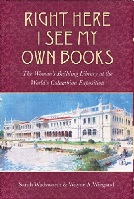 |
02 WAD Sarah Wadsworth and Wayne A. Wiegand. Right here I see my own books : the Woman’s Building Library at the World’s Columbian Exposition Amherst : University of Massachusetts Press, 2012
Contents By invitation only -- Planning and developing the collection -- Empire building -- Grand opening -- "To read her is a liberal education" -- Ghosts and shadows -- "I will write for the people".
Abstract On May 1, 1893, the World’s Columbian Exposition in Chicago opened its gates to an expectant public eager to experience firsthand its architectural beauty, technological marvels, and vast array of cultural treasures gathered from all over the world. Among the most popular of the fair’s attractions was the Woman’s Building, a monumental exhibit hall filled with the products of women’s labor―including more than 8,000 volumes of writing by women. Right Here I See My Own Books examines the progress, content, and significance of this historic first effort to assemble a comprehensive library of women’s texts. By weaving together the behind-the-scenes story of the library’s formation and the stories between the covers of books on display, Wadsworth and Wiegand firmly situate the Woman’s Building Library within the historical context of the 1890s. Interdisciplinary in approach, their book demonstrates how this landmark collection helped consolidate and institutionalize women’s writing in conjunction with the burgeoning women’s movement and the professionalization of librarianship in late nineteenth-century America. Americans in this period debated a wide range of topics, including women’s rights, gender identity, racial politics, nationalism, regionalism, imperialism, and modernity. These debates permeated the cultural climate of the Columbian Exposition. Wadsworth and Wiegand’s book illuminates the range and complexity of American women’s responses to these issues within a public sphere to which the Woman’s Building provided unprecedented access.
Corp.Sub. Woman’s Building (World’s Columbian Exposition, 1893, Chicago, Ill.)
Subject Libraries -- Illinois -- Chicago -- History -- 19th century.
Women authors -- Exhibitions. Literature -- Women authors -- Exhibitions. Library buildings Library architecture 40747 |
 |
133.52 פאר פארקר, ג’וליה תל-אביב : ספרית מעריב, תשנ"א 1991
Subject Astrology
Fortune-telling 40918 |
 |
327.5 דרו דרור, צביקה [תל-אביב] : הקיבוץ המאוחד, תשס"ה 2005
Abstract הספר מספר את סיפורם של אנשים צעירים במלחמת העצמאות, לוחמי חטיבת הראל של הפלמח שהיו בזירת המלחמה הקשה ביותר והחיונית ביותר לעצם קיומה של מדינת ישראל - במערכה על ירושלים והדרך אליה.
Corp.Sub. Palmah. Hativat Har’el
Subject Israel-Arab War, 1948-1949
Israel-Arab War, 1948-1949 -- Campaigns Israel-Arab War, 1948-1949 -- Regimental histories Jerusalem (Israel) -- History -- Siege, 1948 Israel -- History -- War of Independence, 1948-1949 40891 |
 |
371.315.7(063) כנס כנס השנים-עשר לחקר חדשנות וטכנולוגיות למידה ע"ש צ’"ס (תשע"ד : האוניברסיטה הפתוחה) האדם הלומד בעידן הטכנולוגי : הכנס השנים-עשר לחקר חדשנות וטכנולוגיות למידה ע"ש צ’"ס : שלישי-רביעי, י"ח-י"ט בשבט תשע"ז, 15-14 בפברואר 2017 [רעננה] : האוניברסיטה הפתוחה, המרכז לחקר חדשנות בטכנולוגיות למידה, תשע"ז 2017.
Subject Computer-assisted instruction -- Israel -- Congresses.
Distance education -- Computer-assisted instruction -- Israel -- Congresses. Teaching -- Aids and devices -- Israel. Educational technology -- Congresses. 40956 |
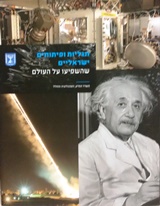 |
608.2(569.4) ישר ישראל. משרד המדע, הטכנולוגיה והחלל תגליות ופיתוחים ישראליים : שהשפיעו על העולם ישראל : משרד המדע, הטכנולוגיה והחלל, תשע"ח 2016
Abstract מנהיגי התנועה הציונית וראשי הישוב היהודי בארץ ישראל, בהם ראש הממשלה דוד בן-גוריון והנשיא פרופ’ חיים ויצמן, ראו בפיתוח המחקר המדעי חלק משמעותי מהמפעל הציוני ומכינון המרכז הרוחני של המדינה היהודית. התערוכה במסדרון היוצאים בנמל התעופה הבינלאומי בן גוריון התערוכה במסדרון היוצאים והנכנסים בנמל התעופה צילום קובי גדעון/לע"מ עוד לפני קום המדינה היו אלה אלברט איינשטיין, מרטין בובר, זיגמונד פרויד, אהרן אהרונסון ומדענים יהודיים אחרים, שראו בהקמת מוסדות ומכוני מחקר מדעיים צורך בעל חשיבות לאומית וכלכלית. רבים מהישגיה של מדינת ישראל, מקורם בתשתית המדעית שנבנתה אז, כמו גם בפוטנציאל המדעי, הטכנולוגי והאנושי העומדים לרשותה כיום. המחקר המדעי הוא שפה אוניברסלית המהווה גשר בין עמים ותרבויות. הישגי המדע הישראלי תורמים רבות לביסוס מעמדה הבינלאומי של המדינה, ומעניקים לה מקום של כבוד בין המדינות המפותחות בעולם. המדעניות והמדענים הישראלים זוכים למוניטין ולהכרה בינלאומיים. גולת הכותרת של הכרה זו היא המדענים הישראלים זוכי פרס נובל, פרס טיורינג, מדליית פילדס ופרסים יוקרתיים נוספים
המדע הישראלי מתאפיין בחדשנות פורצת דרך. בישראל פורחת תעשייה עתירת יידע שתגליותיה ופיתוחיה המדעיים מהווים תרומה לאנושות, בהיותם בעלי השפעה משמעותית על איכות חייהם של מיליארדי אנשים בעולם. ההישגים, התגליות והפיתוחים של המדע הישראלי עוסקים בקשת רחבה של תחומים ונושאים. לישראל תגליות פורצות דרך בתחומי החקלאות, הרפואה, הרובוטיקה, המחשוב, הארכאולוגיה, החלל, המתמטיקה, מדעי החברה והרוח ועוד. בנוסף, ישראל נחשבת למעצמת היי-טק ומהווה כיום מוקד משיכה הן לחברות בינלאומיות אשר מקימות כאן את מרכזי המחקר והפיתוח שלהן, והן לחברות סטרט-אפ בתחומים שונים. בישראל פועלות תשע אוניברסיטאות, ובנוסף, 66 מוסדות להשכלה גבוהה. כמו כן, בישראל השיעור הגבוה בעולם של בעלי תואר אקדמי ביחס לגודל האוכלוסיה. ישראל נמנית על תשע המדינות החברות ב"מועדון החלל" היוקרתי, מדינות שתכננו, פיתחו, ייצרו ושיגרו לוויינים אל החלל. בספר זה תמצאו עשרות תגליות ופיתוחים ישראליים פורצי דרך, אשר הוצגו בתערוכה בנמל התעופה בן-גוריון במהלך 2016. בספר תוכלו לקבל טעימה ולהיחשף למגוון המרתק של תחומי המדע וחידושיו במדינת ישראל, לגלות את השפעתם על האנושות ולהכיר את החוקות והחוקים העומדים מאחוריהם - מתוך הספר Subject Discoveries in science -- Israel.
Science -- Popular works -- Israel. 40945 |
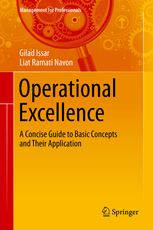 |
658 ISS Gilad Issar, Liat Ramati Navon basic concepts and their application
Cham, Switzerland : Springer, 2016 Contents Introduction -- Assurance of Supply (AOS) -- Cost of Goods (COGs) -- Decision Support Systems (DSS) -- Drum, Buffer, Rope and Days of Inventory (DOI) Control -- Emails (the LEAN Version) -- Empowerment -- Enterprise Resource Planning (ERP).-Failure Mode and Effect Analysis (FMEA) -- Gross Margin (GM) -- Hiring Practices for Operations -- Human Resources (HR) -- Innovation in the Operations -- Interfaces and Their Improvement in Operations -- Just in Time (JIT) -- Kan Ban -- Key Performances Indicators (KPI) -- LEAN Operations -- Leadership in the Operations -- Meetings and LEAN Decision Making -- Manufacturing Overhead (MOH) and Departmental Expense Control -- Manufacturing Excellence in Daily Life -- New Product Introduction (NPI) -- One on One Meeting -- Personal Development -- People Motivation, Productivity and Satisfaction -- Quality -- Return on Investment (ROI) Calculations and CAPEX Decisions -- Safety -- Supply Chain and Win-Win Relations with the Suppliers -- Services and Customer Assurance -- Team Work and its Development -- Theory of Constraint (TOC) -- Variability -- Managing the Variability in Operations -- Voice of the Employee -- Yield, Improvement and Sustaining High Yield -- Where, When and How We Can Apply the Operational Excellence Concise Guide Methods?
Abstract As industrial companies are placing a higher focus on operations, this book comes at the right time with a compilation of basic concepts of Operational Excellence and their application. Operational excellence allows companies to recover from reductions in gross margins and low profitability, which largely occur due to a rise in agile competition and the short life span of new technologies. This book helps managers and consulting academicians as a ready reference for cross-industry implementation of operational excellence.
Subject Organizational effectiveness.
Organizational behavior Production management Industrial management Quality control Business Organization Planning. Operations research Decision making Sales management. 40917 |
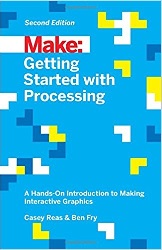 |
681.324.61 REA Reas, Casey Getting started with processing / Second edition
San Francisco, California : Maker Media, 2015 Contents 1. Hello : Sketching and prototyping ; Flexibility ; Giants ; Family tree ; Join in -- 2. Starting the code : Your first program : Draw and ellipse; Make circles ; Show ; Save and new ; Share ; Examples and reference -- 3. Draw : The display window : Draw a window; Draw a point ; Basic shapes : Draw a line; Draw basic shapes; Draw a rectangle; Draw an ellipse; Draw part of an ellipse; Draw with degrees ; Drawing order : Control your drawing order; Put it in reverse ; Shape properties : Set stroke weight; Set stroke caps; Set stroke joins ; Drawing modes : On the corner ; Color : Paint with grays; Control fill and stroke; Draw with color; Set transparency ; Custom shapes : Draw an arrow; Close the gap; Create some creatures ; Comments ; Robot 1: Draw -- 4. Variables : First variables : Reuse the same values; Change values ; Making variables ; Processing variables : Adjust the size, see what follows ; A little math : Basic arithmetic ; Repetition : Do the same thing over and over; Use a for loop; Flex your for loop’s muscles; Fanning out the lines; Kinking out the lines; Embed one for loop in another; Rows and columns; Pins and lines; Halftone dots ; Robot 2: Variables -- 5. Response : Once and forever : The draw() function; The setup() function; Global variables ; Follow : Track the mouse; The dot follows you; Draw continuously; Set line thickness; Easing does it; Smooth lines with easing ; Click : Click the mouse; Detect when not clicked; Multiple mouse buttons ; Location : Find the cursor; The bounds of a circle; The bounds of a rectangle ; Type : Tap a key; Draw some letters; Check for specific keys; Move with arrow keys ; Map : Map values to a range; Map with the map() function ;
Robot 3: Response -- 6. Translate, rotate, scale : Translate : Translating location; Multiple translations ; Rotate : Corner rotation; Center rotation; Translation, then rotation; An articulating arm ; Scale : Scaling; Keeping strokes consistent ; Push and pop : Isolating transformations ; Robot 4: Translate, rotate, scale -- 7. Media : Images : Load an image; Load more images; Mousing around with images; Transparency with a GIF; Transparency with a PNG ; Fonts : Drawing with fonts; Draw text in a box; Store text in a string ; Shapes : Draw with shapes; Scaling shapes; Creating a new shape ; Robot 5. Media -- 8. Motion : Frames : See the frame rate; Set the frame rate ; Speed and direction : Move a shape; Wrap around; Bounce off the wall ; Tweening : Calculate tween positions ; Random : Generate random values; Draw randomly; Move shapes randomly ; Timers : Time passes; Triggering timed events ; Circular : Sine waves values; Sine wave movement; Circular motion; Spirals ; Robot 6: Motion -- 9. Functions : Function basics : Roll the dice; Another way to roll ; Make a function : Draw the owl; Two’s company; An own function; Increasing the surplus population; Owls of different sizes ; Return values : Return a value ; Robot 7: Functions -- Objects : Fields and methods ; Define a class ; Create objects : Make an object; Make multiple objects ; Tabs ; Robot 8: Objects -- 10. Arrays : From variables to arrays : Many variables; Too many variables; Arrays, not variables ; Make a array : Declare and assign an array; Compact array assignment; Assigning to an array in one go; Revisiting the first example ; Repetition and arrays : Filling an array in a for loop; Track mouse movements ; Arrays of objects : Managing many objects; A new way to manage objects; Sequences of images ; Robot 9: Arrays -- Data : Data Summary ; Tables : Read the table; Draw the table; 29,740 cities ; JSON : Read a JSON file; Visualize data from a JSON file ; Network data and APIs : Parsing the weather data; Chaining methods ; Robot 10: Data -- Extend : Sound : Play a sample; Listen to a microphone; Create a sine wave ; Image and PDF export : Saving images; Draw to a PDF ; Hello, Arduino : Read a sensor; Read data from the serial port; Visualizing the data stream; Another way to look at the data -- [Appendices] : A. Coding tips -- B. Data types -- C. Order of operations -- D. Variable scope. Abstract Processing opened up the world of programming to artists, designers, educators, and beginners. This short book gently introduces the core concepts of computer programming and working with Processing. Written by the co-founders of the Processing project, Reas and Fry, Getting Started with Processing shows you how easy it is to make software and systems with interactive graphics. If you’re an artist looking to develop interactive graphics programs or a programmer on your way to becoming an artist, this book will take you where you want to go. Updated with new material on graphics manipulation, data, and for the latest version of Processing.
Title Sub. Processing (Computer program language)
Subject Computer programming
Computer graphics -- Computer programs. Interactive multimedia Computer art -- Computer programs. Art -- Data processing. Art and technology 40848 |
 |
תל-אביב : פיתום הוצאה לאור, תשע"ב 2012.
Abstract הכתיבה על אמנות וצילום היא אמנות בפני עצמה וחלק מהיסטוריה ומאידיאולוגיה. ג’ון ברג’ר (נ’ בלונדון, 1926) הוא אחד הכותבים חדי המבט, החדשניים והמקוריים ביותר על אמנות וצילום. הוא מסוללי הדרך להיסטוריה הרדיקלית-חברתית של האמנות, ששניים ממפיציה באקדמיה היו אי אז בסוף שנות ה-60 ובשנות ה-70 טימותי ג’יימס (T. J.) קלארק ולינדה נוכלין. המסות באסופה "על ההתבוננות" [1980] נכתבו בשנים 1966 – 1979 ורובן פורסמו תחילה בעיתונות; מסותיו של ברג’ר וסדרת הטלוויזיה המהפכנית והנודעת שלו, "דרכי ראייה", ששודרה בבי-בי-סי לראשונה ב-1972, מסמנות פריצת דרך בכתיבה הביקורתית על אמנות וצילום. כוחה של הרדיקליות הפוליטית בנקודת המבט של ברג’ר טמון גם בעצם היחשפותה אז לציבור הרחב באמצעי התקשורת. התפיסה הדמוקרטית שלו הייתה אנטיתזה לדיבור הרשמי, המעונב והמתנשא על אמנות באותה עת, כגון זה של קנת קלארק. מסותיו של ברג’ר הן מופת עד לרגע זה לכתיבה עצמאית - לא פטרונית וגם לא חנפנית, הנוגעת בלי חשש בפרדוקסים של הקיום החברתי והפסיכולוגי.
ה"גיבורה" הראשית במסות שבספר היא הנקודה העיוורת של מבטים שונים ספציפיים; ברג’ר מספר את הדרמה הנוקבת שלה, כפי שהיא עולה, בין היתר, בציורים של טרנר, ז’ורז’ דה לה טור, פרנסיס בייקון, גוסטב קורבה, פראנס האלס, מאגריט, וכן בעבודות של אמנים המכונים "פרימיטיבים", או בספרה הנודע של סוזן זונטאג על הצילום, בתצלומי סבל בעיתונות, ביצירתם של ג’אקומטי, פול סטראנד ואוגוסט זאנדר, וגם באנדרטה הקרויה גן חיות ועוד. כתיבתו מעורבת ומצהירה על מגמתה, מכַוונת לשינוי ומאירה פינות מוצללות הן בתחום של צבע וצורה ואופן פעולה והן בַּתת-מודע הפוליטי בעידן "המטפיזיקה של הכסף" (אם להשתמש בלשונו של ברג’ר). ג’ון ברג’ר הוא סופר, מסאי, מבקר אמנות ותסריטאי. על ספרו מ-1972, "G", זכה בפרס בוּקר. מ-1972 הוא חי בכפר קטן באלפים הצרפתיים, אך הוא מרבה בנסיעות. ספר המסות שלו, שרבות מהן מספרות את החיים תחת כיבוש בגדה המערבית, "אחֹז בכל היקר: איגרות על הישרדות ומרי" [ורסו, 2007], ראה אור בעברית בהוצאת פיתום ב-2008. Subject Art -- Psychological aspects.
Visual perception Meaning (Philosophy) 40779 |
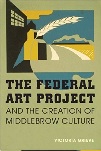 |
7.01 GRI Grieve, Victoria Urbana, Ill. : University of Illinois Press, 2009
Contents The art of experience -- Inventing a usable past -- New museums and new critics -- The Federal Art Project and the making of middlebrow culture -- Marketing the American folk -- Creating the middlebrow consumer
Abstract This intellectual history chronicles the processes of compromise and negotiation between high and low art, federal and local interests, and the Progressive Era and New Deal. Victoria Grieve examines how intellectual trends in the early twentieth century combined with government forces and structures of the New Deal’s Federal Art Project to redefine American taste in the visual arts. Representing more than a response to the emergency of the Great Depression, the Federal Art Project was rooted in Progressive Era cultural theories, the modernist search for a usable past, and developments in the commercial art world in the early decades of the twentieth century. In their desire to create an art for the "common man," FAP artists and administrators used the power of the federal government to disseminate a specific view of American culture, one that combined ideals of uplift with those of accessibility: a middlebrow visual culture.
Corp.Sub. Federal Art Project
Subject Art and state -- United States -- History -- 20th century.
Middle class -- United States -- History -- 20th century Popular culture -- United States -- History -- 20th century. United States -- Cultural policy -- History -- 20th century. 40831 |
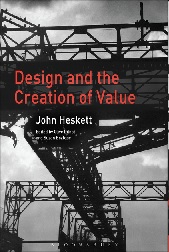 |
7.01 HES Heskett, John London ; New York : Bloomsbury Academic, an imprint of Bloomsbury Publishing PIc, 2017.
Contents Introduction to Design & the Creation of Value / Clive Dilnot -- A note on John Heskett’s economics / Cameron Weber -- Design as an economic necessity for governments and organisations / Sabine Junginger -- Notes on editing the manuscript Design and the Creation of Value / Clive Dilnot -- Design in Economic Life? -- Economic Theory & Design. Neo-Classical Theory -- Austrian Theory -- Institutional Theory -- New Growth Theory -- The National System -- Design & the Creation of Value. Design from Standpoint of Economics -- Economics from the Standpoint of Design -- Design and Value from the Standpoint of Practice -- Appendix 1: Socialist Theory -- Appendix 2: Value and Values in Design -- Afterword / Sharon Helmer Poggenpohl.
Abstract John Heskett was a pioneering British design historian, with a particular interest in design and economics. Design and the Creation of Value’ publishes for the first time his groundbreaking seminar on design and economic value. In remarkably clear and accessible prose Heskett explores the how the key traditions of economic thought conceive of how value is created. Critically teasing out the role of design in this process, Heskett shows how design’s role in innovating and creating value creating value for organisations and products can be given a firm grounding in economic theory. Featuring examples of businesses which have successfully responded to the value of design in their practice, as well as others who have failed because of their inability to understand value-creation, Heskett looks in detail at the relationship between producers, markets, products and consumers, using these instances to offer a both a strong critique of the limitations conventional economic thought and new model of the economic importance of design thinking in value creation.
"John Heskett was a leading design historian with a particular interest in design and economics. This book publishes for the first time his writings on design and economic value, and design’s role in creating value in organisations and products. The first part of Heskett’s text introduces the main traditions of economic thought as they explain the relationship between producers, markets, products and consumers; he then goes on to consider the importance of design and design thinking in innovating and creating value in business practice and product development. Heskett refers to examples of businesses such as Dyson and Apple that have successfully responded to the value of design in their practice, and others such as the Ford Motor Company that were faced with the threat of bankruptcy because they failed to encourage innovation and creativity or to respond adequately to the challenges and opportunities presented by new technology. Heskett’s text is accompanied by critical and contextualising overviews by leading design scholars, which place Heskett’s writings within the framework of contemporary design and business thought and practice"-- Provided by publisher. Subject Design
Design -- Economic aspects. 40830 |
 |
Karlsruhe, Germany : ZKM, Center for Art and Media ; Cambridge, Massachusetts : MIT Press, 2016.
Abstract Modernity has had so many meanings and tries to combine so many contradictory sets of attitudes and values that it has become impossible to use it to define the future. It has ended up crashing like an overloaded computer. Hence the idea is that modernity might need a sort of reset. Not a clean break, not a "tabula rasa," not another iconoclastic gesture, but rather a restart of the complicated programs that have been accumulated, over the course of history, in what is often called the "modernist project." This operation has become all the more urgent now that the ecological mutation is forcing us to reorient ourselves toward an experience of the material world for which we don’t seem to have good recording devices. Reset Modernity! is organized around six procedures that might induce the readers to reset some of those instruments. Once this reset has been completed, readers might be better prepared for a series of new encounters with other cultures. After having been thrown into the modernist maelstrom, those cultures have difficulties that are just as grave as ours in orienting themselves within the notion of modernity. It is not impossible that the course of those encounters might be altered after modernizers have reset their own way of recording their experience of the world.
At the intersection of art, philosophy, and anthropology, Reset Modernity! has assembled close to sixty authors, most of whom have participated, in one way or another, in the Inquiry into Modes of Existence initiated by Bruno Latour. Together they try to see whether such a reset and such encounters have any practicality. Much like the two exhibitions Iconoclash and Making Things Public, this book documents and completes what could be called a "thought exhibition:" Reset Modernity! held at ZKM | Center for Art and Media Karlsruhe from April to August 2016. Like the two others, this book, generously illustrated, includes contributions, excerpts, and works from many authors and artists. Subject Art and technology -- Exhibitions.
Art -- Philosophy -- Exhibitions. 40751 |
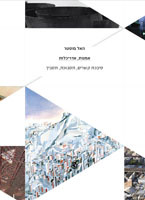 |
7.011 פוס
פוסטר, האל אמנות, אדריכלות : סיבכת קשרים, תסבוכת, תסביך
תל-אביב : פיתום הוצאה לאור, תשע"ג 2013. Contents המפגש בין דימוי לבניין -- א. סגנונות גלובליים : אזרחות על פי הפופ -- ארמונות קריסטל -- מודרניות קלה -- ב. אדריכלות עם פנים לאמנות: מחוות ניאו-אוונגדיות -- מכונות פוסטמודרניות -- מוזיאונים מינימליסטיים -- ג. מדיומים לאחר המינימליזם: מושגים חדשים של פיסול -- קולנוע עירום -- ציור ללא קצוות Abstract
הקשרים בין אדריכלות לבין אמנות, על פי האל פוסטר, הם גורם פעיל בתרבות העכשווית. אם אדריכלים דוגמת זאהה חדיד או הרצוג ודה מרון שואבים מן האמנות על מנת לחדש את העיצוב האדריכלי, האדריכלות מצידה היא מרכיב מחולל שינוי ובעל השלכות בציור, פיסול וקולנוע. פוסטר מנתח את מה שהוא מכנה "סגנון גלובלי" באדריכלות של נורמן פוסטר, ריצ’רד רוג’רס ורנצו פיאנו, ומציג אותו כאנלוגי ל"סגנון הבינלאומי" של לה-קורבוזיה, גרופיוס ומיס ון דר רוהה. סגנון גלובלי זה, הוא טוען, יותר מכל עבודת אמנות, הוא מראיתה של המודרניות העכשווית על מאווייה, אשליותיה וכשליה. פוסטר מראה כיצד יחסי אמנות-אדריכלות הם גורם מרכזי כיום במערך החברתי-כלכלי הרחב ויש להם חלק בתעשיית התודעה... האל פוסטר הוא פרופסור לאמנות ולארכיאולוגיה באוניברסיטת פרינסטון... ספרו הרואה עתה אור בעברית פורסם לראשונה באנגלית ב-2011. הספר הוא ביקורת תרבות לא פחות מאשר ביקורת אמנות ואדריכלות והוא חותר לדרך ביניים בין פרשנות עיתונאית לבין כתיבה תיאורטית של איש מקצוע. -- אתר הוצאת פיתום.
Subject Art and architecture
Art -- Philosophy. Architecture -- 20th century -- History. Architecture -- 20th century. 40778 |
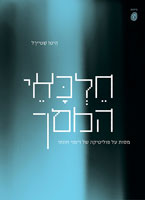 |
7.011 שטי שטיירל, היטו תל אביב : פיתום הוצאה לאור, 2015
Contents פתח דבר / ג’ולייטה אראנדה, בריאן קואן ווד, אנטון וידוקלה -- מבוא / פרנקו "ביפו" ברארדי 00 נפילה חופשית: ניסוי מחשבתי על פרספקטיבה אנכית -- לזכות הדימוי הדל -- דבר כמוך וכמוני -- האם מוזיאון הוא בית חרושת? -- מבע של מחאה -- פוליטיקה של אמנות: אמנות עכשווית והמפנה הפוסט-דמוקרטי -- אמנות כ-occupation - כעיסוק-כיבוש-פלישה: זכות לאוטונומיה של חיים -- חופש מהכול: פרילנסרים ושכירי חרב -- סטטוס נעדרים: מצבי השתרגות, חפיפה והוצאה מהקבר כאתרים של אי-ודאות -- זבלי כדור הארץ: הסתלקות מייצוג -- קאט! שעתוק וצירוף חדש -- תודות מאת המחברת -- אחרית דבר: חוש אפשרות ומנסרות מציאות אצל היטו שטיירל / אסתר דותן.
Abstract מסותיה של האמנית היטו שטיירל (Hito Steyerl, נולדה במינכן 1966) מציגות פוליטיקה של דימוי חזותי, רובד שהיא מפתחת גם בעבודותיה. בד בבד, כתיבתה מתחקה אחר התקווה לפרויקטים קיבוציים גדולים ולסולידריות, משאלה שנדדה מחורבותיהן של הבטחות המודרניזם והשיח הפוסט-קולוניאלי אל דימויים ומסכים ומתגלמת באמצעות הטכנולוגיות החדשות. עבודותיה ומסותיה הן דיאלוג חי, נוקב ולא נוסטלגי עם העת הזאת ועם האמנות והתרבות בעת הזאת. שטיירל היא מהיוצרים המאתגרים והמשפיעים כיום. היא מלמדת באוניברסיטה לאמנות של ברלין. המסות מסיטות את הדיבור מהפוליטיקה של הייצוג אל בחינת הייצוג של הפוליטי. בתוך כך הן מגלות מידע רב במישורים שונים, ביניהם: בתפניות ובעיוותים המשתוללים של הקפיטליזם המואץ; בעולם אמנות המשמש מכרה עצום של כוח עבודה בשירות הכלכלה הפיננסית המופשטת; בָּאלימות המובנית והקונקרטית. ויתר על כן, הן מעלות פרדוקס של מצבים דיאלקטיים המסמנים אפשרויות לתובנות רעננות ולמִפתחים של התערבויות יזומות. עולם הדימויים בכללו אצל שטיירל הוא חלק בלתי נפרד מהמציאות החומרית ומההיסטוריה.
Per.Sub. Steyerl, Hito 1966-
Subject Art, Modern -- 21st century -- Philosophy.
Image (Philosophy) Art -- Political aspects. Art -- Economic aspects. 40777 |
 |
7.036 JOD Jodidio, Philip New York : Rizzoli, 2016
Abstract A must-have design source, with cutting-edge ideas from the world’s best designers and architects. Contemporary Interiors showcases a wide range of twenty-first-century residences by world-renowned architects and designers. Filled with more than 300 color illustrations, specialist Philip Jodidio compiles from around the globe fifty of the most innovative homes designed and built within the last five years. Whether urban or rural, large or small, the book has projects that are international in scope: a summer home in Montauk by Roman & Williams, Houssein Jarouche’s apartment in Brazil by Triptyque; a David Adjaye house in West London; a Luxembourg "eco-green" house by Richard Meier; a Studio Mumbai Palmyra house in India; a Shigeru Ban–designed villa in Sri Lanka; a Tadao Ando house in Monterrey; Sean Godsell’s Edward Street House in Melbourne, Australia. The book has hundreds of design ideas from minimialist white to cozy color that can be applied to each room of the house. Sou Fujimoto experiments with a house that is entirely open, without clearly defined floors; Werner Sobek’s B10 House is designed to be dismantled in one day and rebuilt in the same time frame; Eduardo Arroyo’s house in Spain has iridescent polycarbonate walls that change colors with the light; the Leaf House by Mareines + Patalano architects has a curving swimming pool that enters the house and passes below the dining room where it becomes a pond with aquatic plants and fish; Steven Holl’s gallery and house in Seoul has his signature door that wraps into a corner, notched walls, and neo-constructivist lighting fixtures.
Subject Architecture, Modern -- 21st century
Architecture, Domestic Interior decoration 40832 |
 |
7.036.9(44) ELI Eliel, Carol S. Los Angeles, California : Los Angeles County Museum of Art in association with Harry N. Abrams, 2001.
Contents Purism in Paris, 1918-1925 / Carol S. Eliel -- Amédé Ozenfant, "Purist brother": an essay on his contribution / Françoise Ducros -- Making up the modern city: modernity on display at the 1925 international exposition / Tag Gronberg -- After cubism / Amédé Ozenfant and Charles-Edouard Jeannert [translated by John Goodman].
Abstract The Purist movement in art, founded by Charles-Edouard Jeanneret (better known as Le Corbusier) and Amedee Ozenfant, championed a traditional classicism while it simultaneously embraced new technologies and materials. The only book on Purism, L’Esprit Nouveau is a key contribution to the study of classic 20th-century modernism in painting and architecture. The book serves as the catalogue for an exhibition at the Los Angeles County Museum of Art.The revealing volume examines over 75 paintings by Le Corbusier, Ozenfant, and their closest colleague, Fernand Leger. At the heart of the study lies a single work: Le Corbusier’s striking design of the Pavillon de l’Esprit Nouveau for the 1925 Exposition Internationale des Arts Decoratifs, at which the term "Art Deco" was coined. The architecture of Le Corbusier’s pavilion, along with its interior decoration -- paintings, sculpture, furniture, glassware, rugs, and other objects -- offers a complete summation of Purist aesthetics. Included here too is the full translated text of Le Corbusier’s and Ozenfant’s 1918 manifesto,
Title Sub. Esprit nouveau -- Exhibitions.
Subject Purism (Art) -- France -- Exhibitions
Art, French -- 20th century -- Exhibitions. 40750 |
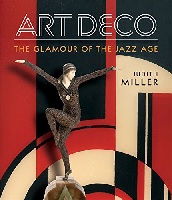 |
7.035.95 MIL Miller, Judith London : Miller’s, a division of Mitchell Beazley, 2016.
Abstract With its streamlined shapes and forward-looking approach, the Art Deco style still looks modern today. In the 1920s and 1930s, designers and craftsmen made innovative use of both natural and man-made materials to produce elegant pieces that broke with tradition and celebrated the future. In this beautifully illustrated guide, antiques expert Judith Miller explores the key makers and pieces of the movement, explaining what to look for as a collector. The book explores all the key collecting areas, with chapters on furniture, glass, ceramics, sculpture, metalwork, silver and plastics, prints and posters, rugs and textiles. With clear price codes and biographies of key makers and designers, the book also contains "A Closer Look" and "Good, Better, Best, Masterpiece" features comparing ranges of items from makers and factories.
A gloriously illustrated and informative celebration of Art Deco, in the same series as Miller’s Arts & Crafts and Miller’s Mid-century Modern. Subject Art deco
40776 |
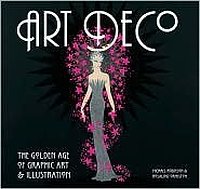 |
7.035.95 ROB Michael Robinson & Rosalind Ormiston. Art deco : the golden age of graphic art & illustration London : Flame Tree Publishing, 2013
Contents The movement -- Fashion -- Advertising.
Abstract This beautifully illustrated book is a celebration of Art Deco’s expression through the graphic arts and illustration. Divided into three sections – the movement, its fashion and advertising – the reader gains great insight into the artists and innovators that helped popularize the Art Deco movement, such as Georges Barbier, Erté, Cassandre and Paul Colin. While the main focus for this intriguing book is centred on graphic art, numerous examples of other forms of Art Deco are also featured. Nestled among the posters and paintings, sculpture, objets d’art and jewellery assert their similarity, whether through line, form or theme. These echoes serve to show the creativity fertility of the period as styles and ideas traversed artistic media.
Follows the development of one of the Twentieth Centurys̀ most glamorous styles. All aspects of 1920s and 1930s design and architecture were affected by its elegant sophistication. Subject Art deco
Art, Modern -- 20th century. Commercial art -- 20th century. Fashion and art -- History -- 20th century. 40775 |
 |
7.037 גרו גרויס, בוריס תל אביב : פיתום הוצאה לאור, תש"ע 2009
Contents חלק א : ההגיון בזכויות אסתטיות שוות לכל.--על החדש.--על האוצרות.--אמנות בעידן הביו-פוליטיקה : מעבודת אמנות לתיעוד אמנות ולאמנות כתיעוד.--איקונוקלזם כאמצעי של אמנות : אסטרטגיות איקונוקלסטיות בקולנוע.--מדימוי אל קובץ של דימוי - ובחזרה : אמנות בעידן הדיגיטלי.--ריבוי מחברים.-- העיר בעידן השעתוק התיירותי.--מחשבות על ביקורת אמנות.
חלק ב : אמנות במלחמה.--גוף הגיבור : תיאוריית האמנות של אדולף היטלר.--לחנך את ההמונים : אמנות סוציאליסטית-ריאליסטית.--מעבר לשונות : לימודי תרבות והאחר הפוסט-קומוניטי.--הפרטות, או גני עדן מלאכותיים של הפוסט-קומוניזם.--אירופה והאחרים. Abstract אמנות מזווית אחרת האוצר ותיאורטיקן האמנות בוריס גרויס מתבונן בתרבות מצדדים בלתי צפויים ומציג בספרו "כוח האמנות" את מורכבותם של היבטים מכריעים ועקרוניים באמנות העכשווית. דרכו מאירת עיניים ופרובוקטיבית כאחד. לאמנות, הוא טוען, יש כוח משלה; היא חלק ממשחק הכוחות של הפוליטיקה הגלובלית כיום - כפי שהייתה, למשל, בימי המלחמה הקרה. אמנות אינה רק בחזקת סחורה חסרת אונים המשועבדת לצווי ההכלה וההדרה של שוק האמנות. לשיטתו, האמנות, בתוך ההתניות של המודרניות, מיוצרת ופועלת בשני מסלולים אפשריים - כסחורה או ככלי פוליטי, ותשומת הלב המועטה יחסית בתוך השיח העכשווי הנתונה לאמנות שמניעיה פוליטיים היא תולדה של הטעם הנוכחי הרווח. הטעם הוא אחד המושגים המרכזיים בהגותו (מכיוון אחר מזה שדן בו פייר בורדייה). גרויס מציג איפיונים של אמנות מודרנית ועכשווית כפועל יוצא של התפקיד האידיאולוגי שהיא ממלאת, ובד בבד מאבחן את מרכיב הטעם באידיאולוגיה.
גרויס מזהה באמנות של הזרם המרכזי במערב נורמות מתחזקות והולכות של תעמולה אידיאולוגית הניכרות בתערוכות הענק ובביינאלות הבינלאומיות שבעיקרן נועדות להמונים. האמנות העכשווית מפגינה את כוחה, הוא טוען, כאשר היא מאמצת מחווֹת איקונוקלסטיות המופנות כלפי עצמה – כלומר, כשהיא מעמידה עצמה כדימוי וכביקורת על הדימוי בו-זמנית. הוא מראה כיצד אסטרטגיית הניכוס מייצרת, בניסוחו, "אובייקט של פרדוקס", שאותו הוא מגדיר כמאפיין היסודי של עבודת אמנות מודרנית. במבטו המקיף, גרויס ממקם את האמנות הנעשית כיום – את המכניזם של המנגנון שבתוכו היא פועלת, את האסטרטגיות האסתטיות שלה, את מוסדותיה ואת מניעיה – בתוך הקשר מעמיק של המהפכנות המודרנית, אורבניזם, טכנולוגיות חדשות והמציאות הפוסט-קומוניסטית. כתיבתו המדויקת, האנליטית וה"קרה", ובה בעת גם האירונית והמחודדת, מחברת ניתוח רב תובנות ומבט אישי עם סוגיות פילוסופיות ונוגעת בלב לבו של ייצור התרבות כיום. הטענות הבלתי צפויות הנבנות בדיון מסקרנות ומאתגרות צדדים בהגות הפוסטמודרנית. א.ד. בוריס גרויס נולד במזרח ברלין בשנת 1947. הוא פרופסור לפילוסופיה ולתיאוריה של האמנות באקדמיה לעיצוב בקרלסרואה, גרמניה, וגלובל-פרופסור באוניברסיטת ניו יורק. הוא מחברם של ספרים רבים, ביניהם: "איליה קבאקוב: האיש שעף מדירתו אל חלל החיצון", 2006. "כוח האמנות" ראה אור לראשונה בהוצאת MIT, קיימברידג’, מסצ’וסטס, 2008. Subject Art -- Political aspects.
Art, Modern -- 20th century -- Philosophy. Art and state 40781 |
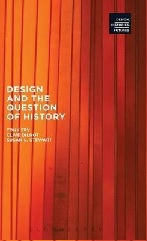 |
London ; New York : Bloomsbury Academic, 2015
Contents Machine generated contents note: -- Preface, Pre-face Essential Reading Book 1: Wither Design/Whether History, Tony Fry Introduction 1. Rememberings & Dismemberings 2. Another History, Another Designing 3. Design in the Maelstrom of Time Book 2: History, Design, Futures, Clive Dilnot Preface Introduction: The structure of existence is undergoing a fundamental change 1. Unhappiness: Lack of History, Lack of the Future 2.The Artificial 3. Destructiveness and its Overcoming 4. Apparatus History Acting Book 3, Susan Stewart And so to another setting..... On Care and Education Index.
Abstract "Design and the Question of History offers a new perspective on the historical significance of design, showing how design is an agent of historical change rather than a single aspect. Despite a historical sensibility being essential in making critical and directional choices, Design History presents an extremely selective view, which cannot deliver the historical knowledge to sufficiently and sensitively inform designers and design thinkers’ practice. Focusing on how the relationship between design and history is understood and presented, this book uses a methodological approach to address this problem. The book covers the issue of history and how design in history needs to be understood by recognising that design is always historically embedded in a relational context; the efficacy of Design History as a sub-discipline within design; and the delivery of a more substantial historical sensibility to emergent designers, identifying the pedagogic problems it presents and discussing the agency of such knowledge in practice. This book is the flagship of the Design, History & Futures series, edited by Tony Fry, Lisa Norton and Anne-Marie Willis"-- Provided by publisher.
Subject Design and history
40828 |
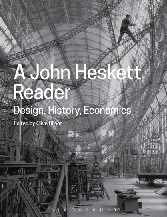 |
7.05 HES Heskett, John London ; New York : Bloomsbury Academic, an imprint of Bloomsbury Publishing PIc, 2016
Contents Machine generated contents note: -- Introduction: Clive DilnotI. Key Themes -- Introduction -- 1. What is Design? -- 2. Commerce or Culture? Industrialization and Design -- 3. Design from the Standpoint of Economics/Economics -- from the Standpoint of DesignII. Design in History & the History of Design -- Introduction -- (A) Designing and Making in the Pre-Industrial World -- 4. Some Lessons of Design History -- 5. Crafts, Commerce, Industry -- 6. Chinese Design: What Can We Learn from the Past? -- 7. Three moments in the History of Making: Nomads, Traders, Slaves -- (B) Designing in the Industrial World -- 8. The ’American System’ and Mass Production -- 9. Writing the History of Design in the Industrial World -- 10. The Growth of Industrial Design in Japan -- (C) Design in Germany 1870-1945 -- 11. Government Policy & German Design 1870-1918 -- 12. The Industrial Applications of Tubular Steel -- 13. Modernism and Archaism in Design in the Third Reich III. Design, Business, Economics -- Introduction -- (A) Corporate design strategies -- Sharon Helmer Poggenpohl: Design between Economics and Practice -- 14. GM: The Price of Corporate Arrogance -- 15. Everything Changes, Nothing Alters -- 16. Design Management in Phillips in the 1980s -- 17. Teaching an Old Dog New Tricks: How RCA is using -- Design as a Strategic Tool -- 18. Current and Future Demands on Hong Kong Designers -- (B) National Design Policies -- Carlos Texeiria: John Heskett and design policy -- 19. National Design Policy and Economic Change -- 20. Learning from Germany’s Integrated Design Policy -- 21. Design and Industry in China -- 22. A Design Policy for the UK: Three Suggestions -- (C) Creating Value by Design -- Tore Kristensen: John Heskett’s contribution to the business -- and economics of design -- 23. Creative Destruction: The Nature and Consequences -- of Change through Design -- 24. Product Integrity -- 25. Cultural Human Factors --
26: Creating Economic Value by DesignIV. Reflections -- Introduction -- 27. Past, Present and Future in Design -- 28. Reflections on Design and Hong Kong -- 29. On WritingV. Last Words -- 30. Can the Centre Hold?List of acronyms -- Contributors -- Permissions and Acknowledgments -- Appendix: A first bibliography of John Heskett’s published work -- Index. Abstract A John Heskett Reader brings together a selection of the celebrated design historian John Heskett’s key works, introduced and edited by Clive Dilnot of Parsons, the New School, USA. Heskett, who passed away in early 2014, was a pioneering British-born writer and lecturer. His research was foundational for the study of industrial design, and his research into the relationship between design, policy and economic value is still a regular reference-point for academics and students alike. This anthology represents well the great range of his work, covering such varied topics as the growth of Japanese industrialism, modernism in the Third Reich, and 1980’s corporate design management. Including both hard-to-access and previously unpublished material like Crafts, Commerce and Industry and Economic Value of Design, the book demonstrates Heskett’s passionate interest in exploring the relationship of design and making with economic value across the entirety of human history. Featured texts include, What is Design, Chinese Design: what can we learn from the past?, The ’American System’ and Mass Production, The Industrial Applications of Tubular Steel, Creative Destruction: the nature and consequences of change through design, Reflections on Design and Hong Kong, besides many others.
Subject Design -- History.
Design -- Economic aspects. Industrial design -- History. 40829 |
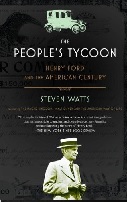 |
7.05-051(73) WAT Watts, Steven New York : Vintage, a division of Random House, 2005
Abstract How a Michigan farm boy became the richest man in America is a classic, almost mythic tale, but never before has Henry Ford’s outsized genius been brought to life so vividly as it is in this engaging and superbly researched biography. The real Henry Ford was a tangle of contradictions. He set off the consumer revolution by producing a car affordable to the masses, all the while lamenting the moral toll exacted by consumerism. He believed in giving his workers a living wage, though he was entirely opposed to union labor. He had a warm and loving relationship with his wife, but sired a son with another woman. A rabid anti-Semite, he nonetheless embraced African American workers in the era of Jim Crow. Uncovering the man behind the myth, situating his achievements and their attendant controversies firmly within the context of early twentieth-century America, Watts has given us a comprehensive, illuminating, and fascinating biography of one of America’s first mass-culture celebrities.
Per.Sub. Ford, Henry 1863-1947
Subject Industrialists -- United States -- Biography.
Automobile industry and trade -- United States -- History Mass production -- United States -- History. 40872 |
 |
72(493) WEB Wever, Peter Rotterdam : Nai010 Publishers, 2015.
Contents Preface / Peter Wever -- Introduction / Ludo van Halem -- Pavilion without a façade : Le Corbusier versus Gerrit Rietveld / Peter Wever -- Woman’s hairpins help to build architecture of the future : an unlikely tale of the conception of the Philips Pavilion -- Colour in the Philips Pavilion : Le Corbusier’s use of types couleurs / Peter Wever -- The decorators : creation of the light effects in Le poème électronique / Peter Wever -- Shadowplay : Pierre Arnaud’s replacement show for the Philips Pavilion / Pierre Arnaud and Peter Wever -- An Austrian in Eindhoven : Anton Buczynski and the recording of Le poème électronique / Kees Tazelaar -- Inside the Philips Pavilion : personal stories from those who operated Le poème électronique / Peter Wever -- That’s entertainment : publicity for the Philips Pavilion / Peter Wever -- The ’electronic poem’ in the Philips Pavilion : a rich and rare experience of a world of wonder -- Like ants in a hurricane : one and a half million visitors to the Philips Pavilion / Peter Wever -- Beyond the final performance : demolition of the Philips Pavilion / Peter Wever and Kees Tazelaar.
Abstract In 1958, Swiss-French architect and urban planner Le Corbusier designed the Philips Pavilion for the World’s Fair in Brussels. It is the only building the artist produced for a Dutch client. The unconventional pavilion was the setting for the experimental performance "Le Poème électronique," by avant-garde composer Edgard Varèse, seen by one and a half million visitors. Combining film, color, music and light, this event is regarded as the first multimedia performance for the general public. After its demolition in 1959, the pavilion became an icon of 20th-century art. The Rijksmuseum in Amsterdam hosts a scale model of the pavilion and also provides the eight-minute soundtrack of "Le Poème électronique." EYE Filmmuseum, also in Amsterdam, has kept the film footage of the performance. This monograph includes a complete overview of the Philips Pavilion, including its history, construction and detailed documentation of "Le Poème électronique."
Per.Sub. Le Corbusier, 1887-1965,
Corp.Sub. Philips Pavilion (Expo, International Exhibitions Bureau, 1958, Brussels, Belgium)
Subject Architecture -- Belgium -- Brussels.
Performance art -- Belgium -- Brussels. Brussels (Belgium) -- Buildings, structures, etc. 40756 |
 |
72.011 OEC Oechslin, Werner Cambridge : Cambridge University Press, 2002.
Abstract Contemporary architectural theory emphasizes the importance of "tectonics," the term used to articulate the relationship among construction, structure, and architectural expression. Yet, little consideration has been given to the term’s origins or historical significance. In this study, Oechslin examines the attempts by early Modern theoreticians of architecture to grapple with the relationship between appearance and essence. He locates the culmination of this search for "truth" in architectural expression in the work of Adolf Loos and the writings of theorists such as Bötticher, Le Corbusier, and Lux.
Per.Sub. Wagner, Otto 1841-1918 -- Criticism and interpretation.
Loos, Adolf, 1870-1933 -- Criticism and interpretation Subject Architecture -- Philosophy.
Architecture -- Composition, proportion, etc. Architecture, Modern -- 19th century. Architecture, Modern -- 20th century. 40745 |
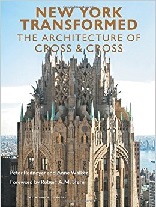 |
72.035/.036 PEN Peter Pennoyer and Anne Walker New York : Monacelli Press, 2014.
Contents The Cross brothers -- Residential New York. Houses ; Clubs ; Apartment buildings, hotels, and real estate development -- Country houses -- Shaping the city and beyond. Civic and institutional projects ; Banks, offices, and commercial buildings
Abstract The architects Cross & Cross shaped the streetscape and skyline of New York City in the 1920s and 1930s with Upper East Side townhouses and apartment buildings, the RCA Victor Building, and Tiffany’s flagship store on 57th Street. Working through a period of American history that saw dramatic change, from luxurious apartment buildings during the economic boom of the 1920s, to federal commissions during the Depression, the brothers John and Eliot Cross were masters of their craft. Well-connected society men who also showed remarkable foresight in business, Cross & Cross supported their practice with a partnered real estate firm and played a vital role in residential developments like Sutton Place along the East River.
Cross & Cross oversaw the development of handsome clubs and houses throughout New York City, including the Links Club and the Upper East Side houses of Lewis Spencer Morris and George Whitney. They designed country houses in exclusive residential pockets outside New York—the Southampton estate of Winterthur founder Henry Francis du Pont; houses on the North Shore of Long Island, and in Greenwich, Connecticut; the childhood home of Sister Parish in Far Hills, New Jersey; and the Shelburne, Vermont home of J. Watson and Electra Webb. In this first book to collect the achievements of Cross & Cross, Peter Pennoyer and Anne Walker present a comprehensive monograph of the firm’s work, with more than 300 illustrations both historic and new and a catalogue raisonné of their projects Corp.Sub. Cross & Cross -- History.
Cross & Cross -- Catalogs Cross, John W., 1878-1951 Cross, Eliot, 1883 or 1884-1949 Subject Architecture -- New York (State) -- New York.
Architecture, Domestic -- New York (State) -- New York -- History -- 20th century. Architecture, Domestic -- United States -- History -- 20th century. Country homes -- New York (State) -- Long Island -- History -- 20th century. Country homes -- United States -- History -- 20th century. New York (N.Y.) -- Buildings, structures, etc. 40851 |
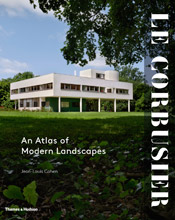 |
72.036 LEC (COH) Le Corbusier New York : Museum of Modern Art, New York , 2013
Contents Portfolio / Richard Pare -- Foreword / Glenn D. Lowry -- From international to territory: the project of an atlas / Barry Bergdoll -- In the cause of landscape / Jean-Louis Cohen -- Switzerland and Germany : The Jura: at the School of the Mountains / Edmond Charrière ; La Chaux-de-Fonds: Villa Jeanneret-Perret, Villa Schwob ; Corseaux: "My father lived one year in this house. The scenery fascinated him" / Bruno Reichlin ; Lake Geneva and the Alps: framing the panorama between Hodler and Duchamp / Stanislaus von Moos ; Geneva: Mundaneum ; Munich to Berlin: the urban space of German cities / Christoph Schnoor -- Italy and the Orient : Bucharest to Istanbul: with William Ritter in the Balkans / Marie-Jeanne Dumont ; Athos to Athens: Greece in the Voyage d’Orient / Yennis Tsiomis ; Rome: a lesson in urban landscape / Jean-Louis Cohen ; Pisa: the enigma of the Piazza del Miracoli / Jacques Lucan ; Capri: "Le ’Vrai’ seul support de l’architecture": folklore, nature, and landscape / Maride Talamona ; Venice: a lesson on the human scale / Maride Talamona -- Europe, west to east : Spain: traveling to see the already seen / Juan José Lahuerta ; Zlin, Czechoslovakia: plan for Bat’a ; Moscow: Asian village to metropolis / Jean-Louis Cohen ; Moscow: Centrosoyuz Headquarters ; Moscow: Palace of the Soviets -- France :
Atlantic Coast: nature as inspiration / Tim Benton ; Aquitaine: on the wilder shores of modernism / Niklas Maak ; Pessac: quartiers modernes frugès ; Le Pradet: "The composition is shaped by the landscape" / Bruno Reichlin ; Piacé: Ferme radieuse and village radieux / Mary McLeod ; Sanit-Dié: "A modern space conception" for postwar reconstruction / Mary McLeod ; Marseille: Unité d’Habitation, or the company of clouds, the sky, or the stars / Tim Benton ; Ronchamp: a landscape of visual acoustics / Josep Quetglas ; Eveux-sur-l’Arbresle: Convent of Sainte=Marie de las Tourette / Roquebrune-Cap-Martin: Roq and Rob, Cabanon -- Paris : Rue Jacob: landscapes drawn and painted "in the evening, by lamplight" / Danièl Pauly ; Rue Nungesser-et-Coli: in the painter’s studio, in search of an expanded syntax / Genevieve Hendricks ; 36 Rue de Sèvres: at work in the atelier / Maristella Casciato ; Paris: La Corbusier and the nineteenth-century city / Barry Bergdoll ; Paris: a mythical and political landscape / Jean-Louis Cohen ; Paris: Maison La Roche-Jeanneret ; Garches: Villa Stein-de Monzie ; Paris: Plan Voisin ; Poissy: Villa Savoye ; Paris and the suburbs: interior and landscape, contrasts and analogies / Arthur Rüegg ; Paris: Beistegui Apartment, or horizons deferred / Anthony Vidler ; Ville d’Avray: pavilions for villa church ; Paris: A cardboard promenade for the 1937 Exposition Internationale / Romy Golan ; Paris: Îlot Insalubre no.6 ; Neuilly: Maisons Jaoul and the suburban site / Caroline Maniaque-Benton -- Africa : Algers: city, infrastructure, and landscape / Antoine Picon ; Nemours, Algeria: plan for city and harbor ; Chardaïa, Algeria: seeing and writing in a desert oasis / Guillemette Morel Journel -- The Americas : Argentina: the Pampa’s sublime, or the geographical gaze / Jorge Francisco Liernur ; Buenos Aires: urban plans ; São Paulo, Rio de Janeiro, and Brasilia: Le Corbusier and the Brazili Abstract In June 2013, The Museum of Modern Art presents the largest exhibition ever produced on Le Corbusier’s prolific oeuvre, encompassing his work as architect, interior designer, artist, city planner, writer and photographer. Over a six-decade career, this towering figure of modern culture constantly observed and imagined landscapes using all the artistic techniques at his command, including watercolors, sketches, paintings, photographs and models. This accompanying publication, appearing 25 years after the Centre Pompidou released the seminal catalogue Le Corbusier, une encyclopédie, aspires to become a new sourcebook, giving an account of research developed worldwide in recent decades. Reflecting the geographic extension of his designs and built works as well as his indefatigable wanderlust, the book is structured as an atlas, with topographical entries allowing for the discovery of the major sites and cities where Le Corbusier worked. Featuring essays by an international range of curators, scholars and critics, and a trove of archival images and materials from the Fondation Le Corbusier in Paris, this lavishly illustrated volume presents a wholly unique way to explore the life and work of one of the most important visionaries of our time.
Per.Sub. Le Corbusier, 1887-1965,
Le Corbusier, 1887-1965 -- Exhibitions. Subject Architecture, Modern -- Exhibitions.
Architecture -- Environmental aspects -- Exhibitions. 40754 |
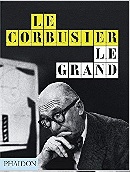 |
72.036 LEC (COH) Le Corbusier London : Phaidon Press, 2014.
Contents [Foreword:] The man with a hundred faces / by Jean-Louis Cohen -- 1. Childhood and early travels (1887-1917) -- 2. Becoming Le Corbusier (1917-1926) -- 3. Urban visions and purist villas (1922-1935) -- 4. In search of the big commission (1926-1942) -- 5. Paris, Vichy and the war (1937-1943) -- 6. Grand projects on a human scale (1942-1952) -- 7. Passage to India (1950-962) -- 8. The sacred and the sublime (1950-1959) -- 9. Mediterranean days (1950-1959) -- 10. Retrospection (1954-1965) -- Documents, notes, chronology, selected bibliography, index.
Abstract Examines the life and work of the influential architect, discussing the influences of his work, the evolution of his design theories, and his legacy on the history of architecture.
Per.Sub. Le Corbusier, 1887-1965,
Subject Architects -- Switzerland -- Biography.
40752 |
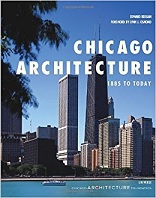 |
72.036(737.3) KEE Keegan, Edward New York : Universe, 2008.
Contents Introduction -- Glessner House -- Auditorium Building -- The Rookery -- Second Leiter Building -- The Monadnock -- Marquette Building -- Reliance Building -- Chicago Cultural Center -- Carson Pirie Scott & Co. -- Macy’s State Street -- Robie House -- Wrigley Building -- Tribune Tower -- Carl Street Studies -- Chicago Board of Trade -- Merchandise Mart -- University Building -- Myron Bachman House -- 860-880 North Lake Shore Drive -- Crown Hall -- 30 West Monroe -- Marina City -- Richard J. Daley Center -- John Hancock Center -- McCormick Place -- Federal Center -- Sears Tower -- Metropolitan Correctional Facility -- Steel & Glass House -- 333 Wacker Drive -- James R. Thompson Center -- Harold Washington Library Center -- Little Village Academy -- Private Residence -- Republic Windows & Doors -- Archer Courts -- Soldier Field -- McCormick Tribune Campus Center -- Jay Pritzker Pavillion -- Contemporaine -- Hyatt Center -- Gary Comer Youth Center.
Abstract Universally recognized as an architectural center, Chicago contains some of the world’s finest buildings by the most renowned architects of the nineteenth and twentieth centuries. Frank Lloyd Wright, Louis Sullivan, Mies van der Rohe, and many more left their stamp on the city’s skyline and, as a result, influenced the practice of architecture across the globe. This book, published in association with the Chicago Architecture Foundation, features an in-depth analysis of forty-two seminal works of Chicago architecture. This accessible and engaging volume is the latest addition to the successful Universe Architecture Series. Both a guide for those visiting the city and a valuable reference for architecture enthusiasts, Chicago Architecture includes residential icons such as Mies van der Rohe’s 860–880 Lake Shore Drive, skyscraper prototypes such as Sullivan’s Schlesinger and Mayer Store (Carson Pirie Scott & Co.), and engineering masterpieces such as Skidmore, Owings & Merrill’s Sears Tower.
Subject Architecture -- Illinois -- Chicago.
Chicago (Ill.) -- Buildings, structures, etc. 40852 |
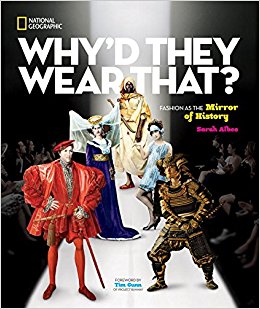 |
745:687.01 ALB Albee, Sarah Washington, D.C. : National Geographic, 2015.
Contents That's a wrap: the ancient world: 10,000 B.C. - A.D. 1000 -- Keeping the faith: the middle ages: 1000 - 1400s -- Going global: the age of exploration: 1400s - early 1500s -- Ruff & ready: the Renaissance: 1500s - early 1600s -- Lighten up!: the age of reason: 1600s - 1700s -- Hats (and heads) off: revolutionary times: mid-1600s - early 1800s -- Growing pains: marching toward modernity: mid-1700s - early 1900s -- Labor pains: the industrial revolution: mid-1800s - early 1900s -- Class dismissed: world at war: the 20th century & beyond -- What can you do? -- Time line.
Abstract Learn about outrageous, politically-perilous, funky, disgusting, regrettable, and life-threatening creations people have worn throughout the course of human history, all the way up to the present day. From spats and togas to hoop skirts and hair shirts, why people wore what they did is an illuminating way to look at the social, economic, political, and moral climates throughout history.
Move over Project Runway. Get ready to chuckle your way through centuries of fashion dos and don'ts! In this humorous and approachable narrative, kids will learn about outrageous, politically-perilous, funky, disgusting, regrettable, and life-threatening creations people have worn throughout the course of human history, all the way up to the present day. From spats and togas to hoop skirts and hair shirts, why people wore what they did is an illuminating way to look at the social, economic, political, and moral climates throughout history. Subject Fashion -- History -- Juvenile literature. Clothing and dress -- History -- Juvenile literature. Fashion -- History. Clothing and dress -- History. 40770 |
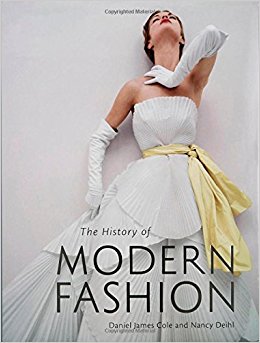 |
London : Laurence King Publishing, 2015.
Contents 1850-1890: the dawn of modern clothing -- The 1890s: extremes of the Gilded Age -- The 1900s: a new century -- The 1910s: exotic fantasy, wartime reality -- The 1920s: les années folles -- The 1930s: aspirations of glamour -- The 1940s: war and recovery -- The 1950s: couture opulence, suburban style -- The 1960s: fashion for the future -- The 1970s: revivals and individuality -- The 1980s: power dressing and postmodernism -- The 1990s: subcultures and supermodels -- The 2000s: mixed messages.
Abstract This lavishly illustrated book looks at the history of fashion from 1850 to 2010. Taking a decade-by-decade approach, Daniel James Cole and Nancy Deihl explore the history of fashion as a lively and dynamic manifestation of twentieth-century culture. Covering chronological changes in womenswear, menswear, and childrenswear, the book looks at the dissemination of style and the mechanisms of change, at the relationship between fashion and the visual, applied, and performing arts, the intertwined relationship between fashion and popular culture, the impact of new materials and technology, and the growing globalization of style. Illustrated with photographs of costume from museums and images from the fashion press including editorial photography, illustrations, and advertising, the book will include insights into icons of fashion and the clothes worn by "real people", providing a valuable visual reference for the reader.
Subject Fashion -- History -- 19th century.
Fashion -- History -- 20th century. Fashion -- History -- 21st century. 40772 |
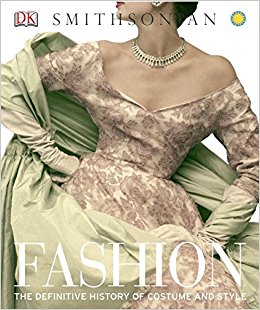 |
New York : DK Publishing, 2012.
Contents Prehistory-600CE: the Ancient world -- 600-1449: Medieval romance and trade -- 1450-1624: Renaissance splendor -- |t 1625-1789: Baroque and Rococo -- |t 1790-1900: from revolution to frivolity -- 1901-1928: la belle epoque and the jazz age -- 1929-1946: from glamour to utility -- 1947-1964: optimism and youth -- 1964-1979: swinging sixties to glam rock -- 1980 onward: the designer decades.
Abstract Tracing the evolution of fashion — from the early draped fabrics of ancient times to the catwalk couture of today — Fashion: The Definitive History of Costume and Style is a stunningly illustrated guide to more than three thousand years of shifting trends and innovative developments in the world of clothing. Containing everything you need to know about changing fashion and style — from ancient Egyptian dress to Space Age Fashion and Grunge — and information on icons like Marie Antoinette, Clara Bow, Jacqueline Kennedy, and Alexander McQueen, Fashion catalogs the history of what people wear, revealing how Western fashion has been influenced by design from around the world and celebrating costume and haute couture. Fashion will captivate anyone interested in style — whether it’s the fashion-mad teen in Tokyo, the wannabe designer in college, or the fashionista intrigued by the violent origins of the stiletto and the birth of bling.
"From simple to sophisticated, elegant to excessive, what we wear says who we are. "Fashion" is the ultimate visual guide to everything ever worn. From the extravagance of Ancient Egypt, through the legendary fashion houses of Chanel and Dior, to the latest cutting-edge labels, this gorgeous collection of costume and dress shows how fashion reflects people and places, and captures the times in which they lived."--p.[4] of cover. Subject Fashion -- History.
Clothing and dress -- History. 40773 |
|
|
745:687.01 FAS Fashion : the collection of the Kyoto Costume Institute: a history from the 18th to the 20th century Köln : Taschen, 2015. Contents The shift from Rococo to revolution : fashion in the 18th century / Tamami Suoh -- The upswing of industrialization : fashion in the 19th century / Miki Iwagami -- The influence of haute couture : fashion in the first half of the 20th century / Reiko Koga -- The age of technological innovation : fashion in the second half of the 20th century / Rie Nii -- Appendix : designers and fashion houses Abstract Clothes define people. A person’s attire, whether it’s a sari, kimono, or business suit, is an essential code to his or her culture, class, personality, even faith. Founded in 1978, the Kyoto Costume Institute recognizes the importance of understanding clothes from sociological, historical, and artistic perspectives. With one of the world’s most extensive clothing collections, the KCI has amassed a wide range of historical garments, underwear, shoes, and fashion accessories dating from the 18th century to the present day. Showcasing the Institute’s vast collection, Fashion is a fascinating excursion through the last three centuries of clothing trends. Featuring impeccable photography of clothing expertly displayed and arranged on custom-made mannequins, it is a testimony to attire as “an essential manifestation of our very being” and to the Institute’s passion for fashion as a complex and intricate art form. The book’s authors include some of the smartest minds and sharpest eyes in fashion studies: Akiko Fukai (Chief Curator of The Kyoto Costume Institute), Tamami Suoh (Curator of The Kyoto Costume Institute), Miki Iwagami (Lecturer of fashion history at Sugino Fashion College (Tokyo)), Reiko Koga (Professor of fashion history at Bunka Women’s University), and Rie Nii (Associate Curator of The Kyoto Costume Institute). Corp.Sub. Kyoto Fukushoku Bunka Kenkyu Zaidan -- Exhibitions. Subject Costume -- History -- Exhibitions. Fashion -- History -- Exhibitions. 40771 |
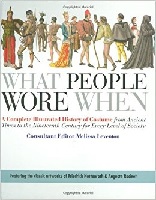 |
New York : St. Martin’s Griffin, 2008.
Contents The grammar of costume -- The ancient world -- The Roman Empire -- Europe in the middle ages -- Renaissance Europe -- Modern Europe, 1650-1840 -- East and Southeast Asia -- South Asia -- Anatolia, Persia, and Central Asia -- European regional dress -- Africa, Oceania, and the Americas -- The elements of costume -- Clothing through the ages -- Accessories through the ages.
Abstract What People Wore When combines the studies of two classic nineteenth-century illustrators Auguste Racinet and Friedrich Hottenroth for the first time. Their works are presented first by chronology and then by subject, so that illustrators, historians, and students alike can choose to follow the path of fashion through the centuries, or study in detail the contrasting styles of individual clothing and accessories. Silhouettes reveal the shape of style through the ages, detailed cross-references draw attention to recurring motifs, and navigation bars help the researcher to travel the complex chronology of costume. With authoritative narrative from leading experts in the history of costume, extraordinary contemporary quotes that reveal the impact of style in its day, detailed annotation, and an extensive glossary, the book provides a magnificent study of the rich vocabulary of style through the ages.
Subject Clothing and dress -- History.
Fashion design 40769 |
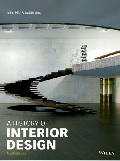 |
747 PIL John Pile & Judith Gura. A history of interior design / Fourth edition London : Laurence King Publishing, 2013. Abstract A History of Interior Design tells the story of 6,000 years of domestic and public space. This fully updated fourth edition includes a completely new chapter on twenty-first-century interior design and a heavily revised chapter on the late twentieth century. Interior design is a field that includes construction, architecture, furniture, decoration, technology and product design. This one-volume history weaves together these topics in a fascinating narrative that runs from cave dwellings and temple architecture, through Gothic cathedrals and Renaissance palaces, to the grand civic spaces of the nineteenth century and the sleek interiors of modern skyscrapers. Embedded in a social and political context, detailed discussions of famous buildings, from cathedrals to Koolhaas, are interspersed with investigations of the domestic vernacular - the cottages, farmhouses, apartments and city terraces inhabited by ordinary people. The new edition of this bestselling history includes over 50 new images and many previously black and white images updated to colour.
Subject Interior decoration -- History.
Interior architecture -- History. 40879 |
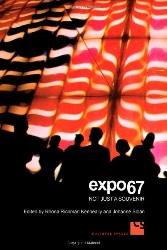 |
Toronto : University of Toronto Press, 2010.
Contents List of illustrations -- Acknowledgments -- Introduction : dusting off the souvenir / Rhona Richman Kenneally and Johanne Sloan -- "The greatest dining extravaganza in Canada’s history : food, nationalism, and authenticity at Expo 67 / Rhona Richman Kenneally -- "Britain Today" at Expo 67 / Elizabeth Darling -- "Une terre humaine" : Expo 67, Canadian women, and Chatelaine/Chatelaine / Eva-Marie Kroller -- Obsolescence as progress and regression : technology, temporality, and architecture at Expo 67 / Tom McDonough -- Ambiguous modernity of designer Julien Hebert / Martin Racine -- Girl watching at Expo 67 / Aurora Wallace -- Into the Labyrinth : phantasmagoria at Expo 67 / Ben Highmore -- Christian Pavilion at Expo 67 : notes from Charles Gagnon’s archive / Monika Kin Gagnon -- Andy Warhol at Expo 67 : pop in and pop out / Jean-Francois Cote -- Postcards from the chromophilic visual culture of Expo 67 / Johanne Sloan -- Montréal and the megastructure, ca 1967 / Inderbir Singh Riar -- Brian Jungen : Habitat 04 / Kitty Scott -- Tabloid expo / Will Straw -- Contributors.
Abstract Expo 67, the world’s fair held in Montreal during the summer of 1967, brought architecture, art, design, and technology together into a glittering modern package. Heralding the ideal city of the future to its visitors, the Expo site was perceived by critics as a laboratory for urban and architectural design as well as for cultural exchange, intended to enhance global understanding and international cooperation. This collection of essays brings new critical perspectives to Expo 67, an event that left behind a significant material and imaginative legacy. The contributors to this volume reflect a variety of interdisciplinary approaches and address Expo 67 across a broad spectrum ranging from architecture and film to more ephemeral markers such as postcards, menus, pavilion displays, or the uniforms of the hostesses employed on the site. Collectively, the essays explore issues of nationalism, the interplay of tradition and modernity, twentieth-century discourse about urban experience, and the enduring impact of Expo 67’s technological experimentation. Expo 67: Not Just a Souvenir is a compelling examination of a world’s fair that had a profound impact locally, nationally, and internationally.
Conf.Sub. Expo (International Exhibitions Bureau) (1967 : Montreal, Quebec) Expo 67 (Montreal, Quebec) Subject Exhibitions -- History.
Technological innovations 40749 |
 |
747:659.152 SMI Duane A. Smith, Karen A. Vendl, Mark A. Vendl. Colorado goes to the fair : World’s Columbian exposition, Chicago, 1893 Albuquerque : University of New Mexico Press, 2011
Contents Preface: You must see this fair -- Prologue: Metropolis of the West -- The fair comes to Chicago -- Come, come, come to the fair : World’s Columbian Exposition -- Surprise to the world -- Not matter, but mind; not things, but men -- Temptations galore -- Coloradans go to the fair : their experiences and opinions -- Epilogue: The glory and the reality -- Appendix: Colorado exhibits receiving awards.
Abstract In many ways, the 1893 World’s Columbian Exposition in Chicago, more popularly known as the Chicago World’s Fair, symbolized the American people’s belief that today’s glory and tomorrow’s future rested with them, their country, and their democracy. A six-month extravaganza of education, entertainment, and amazement, it sparkled in the daytime and emerged at night, seductive and enchanting. The Fair aroused patriotism, pride, and a sense of achievement in almost all Americans, yet 1893 proved a troubling year for the United States, and for the young state of Colorado in particular. The repeal of the Sherman Silver Purchase Act created labor tension in the Colorado mines and contributed to a devastating national depression that would have a lingering impact on Colorado for years. In this heavily illustrated text, the authors trace the glory of the World’s Fair and the impact it would have on Colorado, where Gilded Age excess clashed with the enthusiasm of westward expansion.
Conf.Sub. World’s Columbian Exposition 1893 : Chicago, Ill.) -- History.
World’s Columbian Exposition 1893 : Chicago, Ill. -- Influence. Subject Exhibitions -- Social aspects -- Colorado -- History -- 19th century.
Social change -- Colorado -- History -- 19th century. Colorado -- History -- 1876-1950. Colorado -- Social conditions -- 19th century. Colorado -- Economic conditions -- 19th century. 40753 |
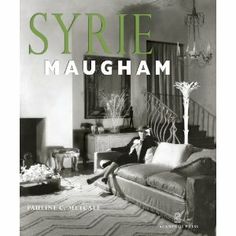 |
747(42) MET Metcalf, Pauline C. New York : Acanthus Press, 2010.
Contents Artistic coterie -- Syrie Maugham shops -- Syrie Maugham residences -- Noel Coward -- Prince of Wales and Wallace Simpson -- Celia Tobin Clark -- Mona and Harrison Williams -- Stephen Tennant -- Hannah and Robert Hudson -- Grace and Harry Payne Bingham -- Evelyn Marshall Field -- Beatrice Benjamin Cartwright -- Decoration a la mode in Mayfair -- Helen and George Hay Whigham -- Robert Sweeny -- Audrey Field -- Rose and William Leveson-Gower -- Rebecca and Israel Sieff -- Liza and Vincent Paravicini -- Dispersing American glamour -- Lila and Dewitt Wallace -- Interiors with stars -- Legacy -- Catalog of projects.
Abstract Trendsetter, fashion icon, and wife of an internationally renowned novelist, the interior designer Syrie Maugham (1879 1955) created an ultra-chic world that was as unique as it was influential. Her ethereal all-white rooms of the 1920s and 30s were echoed in high-style interiors around the world and translated into sets for movies and theatrical productions. Much of the look we associate with the Hollywood glamour of the 1930s owes its simple elegance to Maugham s pared-down aesthetic. Acanthus Press’ September 2010 release of Syrie Maugham celebrates the work of this legendary British designer in the first comprehensive study of her dramatic life and meteoric career. Author Pauline C. Metcalf takes readers on a lively transatlantic voyage through Maugham’s world, from the drawing rooms she decorated in London to the houses, villas, and apartments commissioned by clients in the United States and the Continent. With nearly three hundred photographs and illustrations, Syrie Maugham also profiles the designer’s international clientele, a rarified group that included British royals, European aristocrats, American socialites, and Broadway stars. In Maugham’s blend of traditional refinement and the Style Moderne, with occasional Surrealist flourish console tables floating on dolphin bases, fringed sleigh beds, sheepskin rugs, and miles of mirrored screens this cosmopolitan beau monde discovered a perfect expression of cafe-society chic.
Per.Sub. Maugham, Syrie 1879-1955 -- Themes, motives.
Subject Interior decoration -- England -- History -- 20th century.
40494 |
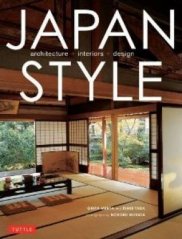 |
747(52) TAD Kimie Tada and Geeta Mehta Tokyo : Tuttle Publishing, 2013.
Abstract Japan Style introduces 20 special residences. With more than 200 color photographs, this book showcases Japanese design in the stunning beauty of old homes and reveals how they are cared for by their owners. Traditional Japanese homes, with superbly crafted fine wood, great workmanship and seasonal interior arrangements, have an aesthetic of infinite simplicity. Unlike Japanese inns and historical buildings, the Japanese architecture featured in this book is on private property not open to public viewing. Japan Style offers a rare glimpse into the intimate world of everyday Japanese culture and fascinating insight into the traditional architecture of Japan.
Subject Interior decoration -- Japan.
Architecture, Domestic -- Japan. 40838 |
 |
749.1(82) CHE Chen, Aric author Brazil modern : the rediscovery of twentieth-century Brazilian furniture New York, NY : Monacelli Press, 2016.
Contents The beginnings -- The Brazilian avant-garde -- On the margins of industry : a question of paths, 1945-1960 -- A Brazilian design industry : 1950-1964 -- After modernism : design, dissent and rediscovery, 1964-1985
Abstract Twentieth-century Brazilian furniture design is perhaps the last great largely unknown tradition of modernism, characterized by rich and sensually textured hardwoods and an ingenuity, grace, and simplicity that exemplify the national character of brasiliadade. With well over 400 historic images and new photography, Brazil Modern: The Rediscovery of Twentieth-Century Brazilian Furniture surveys the history and legacy of this innovative design tradition. Featuring the work of the titans of Brazilian design—Lina Bo Bardi, Oscar Niemeyer, Joaquim Tenreiro, and Sergio Rodrigues—as well as numerous designers whose work and reputations only recently reached foreign shores, Brazil Modern is the first comprehensive guide to this untapped vein of modernist design.
Subject Furniture -- Brazil -- History -- 20th century.
Furniture design -- Brazil -- 20th century 40826 |
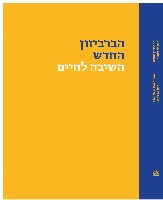 |
עין חרוד : משכן לאמנות עין-חרוד, 2017
Contents פתח דבר / יניב שפירא -- להתבונן ב’ציור מהתבוננות’ / יניב שפירא -- הברביזון החדש / אבדיי טר-אוגניאן -- מעיירה ביער לווילה בג’ונגל : עיון חתרני בברביזון החדש / ניקולה טרזי -- ביוגרפיות -- תערוכות ופרויקטים -- פרויקטים 2016-2011 -- נווה שאנן, תל-אביב 2016-2011 -- כיכר רבין, תל-אביב 2015-2013 -- השוק הבדואי, באר-שבע 2013 -- דיוקנאות נשים 2016-2013 -- קיבוצים : ברעם, עין חרוד 2016-2013 -- התחנה המרכזית החדשה, תל-אביב 2014-2012 -- חורה, נגב 2014 -- רוסיה: פרם, מוסקבה, סנט פטרבורג 2013-2011 -- גרמניה: ברלין, לייפציג, דיסלדורף 2016-2013 -- ישראל: תל-אביב - יפו, חיפה, ראש פינה, ירושלים 2016-2011 -- יצירותמופת 2016-2014 -- עבודות אישיות 2016-2011 -- נטליה זורבובה -- אסיה לוקין -- אנה לוקשבסקי -- אולגה קונדינה -- זויה צ’רקסקי-נאדי.
Abstract מאז החלו לפעול יחד לפני כשש שנים, מיצבה את עצמה קבוצת אמניות זו כאבן דרך באמנות המקומית בהציען מבט פנורמי על המציאות הישראלית. הניסיון למפות את נושאי הציור של ’הברביזון החדש’ מאיר בפנינו מנעד רחב של מראות ונופים...מבט פנורמי זה מאפשר לבחון את ריבוי הפנים והמשמעויות ביצירתן של אמניות אלה, הן כיחידות והן כקבוצה. עולמה היוצר של כל אחת עוצב מתוך רבדים עמוקים של התרבות הרוסית, חיבוטי זהות, השתרשות והתמודדות עם שאלות ציוריות. כקבוצה הן מתכנסות ביציאה משותפת אל מחוץ לסטודיו ו’ציור מהתבוננות’, ברוח מסורת הציור ’באוויר הפתוח’ (en plein air) שהתגבשה בצרפת בשלהי המאה ה-19. החזרה ל’ציור מהתבוננות’ ויישומו בתוככי זירת האמנות המקומית זוכה ליתר תוקף בהציעה חיבור בין מסורות אמנותיות לציור עכשווי, בין התרבות האירופאית והרוסית בפרט להוויית היומיומית הישראלית. מגוון הקולות, הפרשנויות והשאלות שמעוררים הציורים של ’הברביזון החדש’ מלמדים על הרלוונטיות והרעננות של אמניות אלה." -- אתר משכן לאמנות עין חרוד.
Corp.Sub. ברביזון החדש
Barbizon he-hadash Subject Women painters -- Israel -- Exhibitions
Jews, Russian -- Israel -- Biography 40822 |
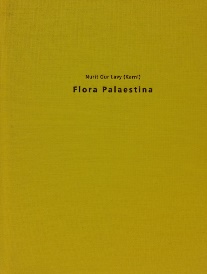 |
75.036(569.4) גור גור לביא (קרני), נורית ישראל : [מוציא לאור לא ידוע], תשע"ו 2016
Per.Sub. Gur Lavi, Nurit, 1952 -
Subject Painting -- Israel -- 21st century.
Art, Israeli Plants -- Israel -- Pictorial works. Flowers -- Israel -- Pictorial works. 40893 |
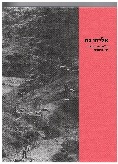 |
75.036(569.4) גת (ברט) ברטוש, רון ישראל : ברוש ; אוניברסיטת בן-גוריון בנגב, תשע"ז 2017
Per.Sub. Gat, Eliahu, 1919-1987
Subject Painters -- Israel -- 20th century.
Art, Israeli -- 20th century 40942 |
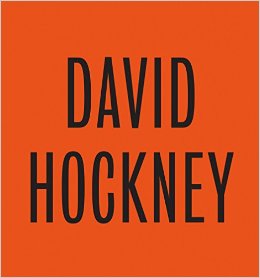 |
London : Tate Publishing, 2017
Abstract A full career retrospective of one of the greatest and most popular living artists, lavishly illustrated with works from across the artist’s six-decade career David Hockney has been delighting and challenging audiences for almost sixty years. Working in an extraordinarily wide range of media with equal measures of wit and intelligence, his art has examined, probed and questioned how the perceived world of movement, space and time can be captured in two dimensions. This lavishly illustrated publication reasserts Hockney as a serious thinker and a highly innovative artist constantly challenging the conventions of artistic expression, without losing the characteristic verve, humour and colour of the work. Hockney?s book describes more than 200 works including painting, drawings, photographs, watercolours, iPad drawings, and his most recent multi-screen works. Exhibition: Tate Britain, London, United Kingdom
David Hockney has been delighting and challenging art lovers for almost 60 years. Working in a wide range of media with wit and intelligence, his art has examined, probed, and questioned how the perceived world of movement, space, and time can be captured in two dimensions. This stunning monograph and the retrospective exhibition it accompanies explore Hockney’s entire career, allowing an overview of his constantly evolving style and exploring his return to favored themes. From abstract expressionism to naturalism to his play with illusion and imagination, parody, and self-reflexivity, Hockney’s preoccupation with looking, perception, and representation can be traced throughout. Showcasing more than 200 works in all media from across the six decades of Hockney’s remarkable career, this book will delight existing fans of the artist while giving new audiences the fullest possible introduction to his life and work. The book is the catalogue for the acclaimed exhibition originating at Tate Britain in February 2017 and traveling to the Centre Georges Pompidou, Paris, and the Metropolitan Museum of Art, New York. Per.Sub. Hockney, David 1937- -- Criticism and interpretation
Hockney, David -- Exhibitions Subject Pop art -- Great Britain.
Artists -- Great Britain -- 20th century. 40824 |
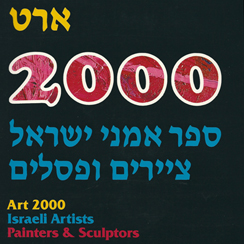 |
תל-אביב : סטודיו חיט, תשנ"ג 1993
Subject Painters -- Israel -- 20th century.
Sculptors -- Israel -- 20th century Art, Israeli -- 20th century Painting, Israeli -- 20th century Sculpture, Israeli -- 20th century 40909 |
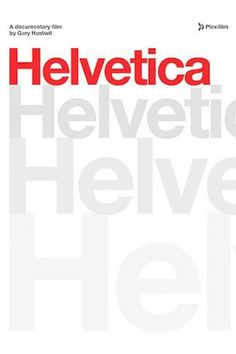
|
76.026 HUS Hustwit, Gary Helvetica [videorecording] produced and directed Gary Hustwit.
New York] : Plexifilm ; Swiss Dots, 2007 Abstract A feature-length documentary film about typography, graphic design and global visual culture. It looks at the proliferation of one typeface (which celebrated its 50th birthday in 2007) as part of a larger conversation about the way type affects our lives
Subject Helvetica type -- Videorecordings
Printing -- Videorecordings. Fonts -- Videorecordings Graphic design (Typography) -- Videorecordings. Graphic arts -- Videorecordings. Documentary films -- Videorecordings. 40757 |
 |
76.026(52) MAR Marks, Andreas okyo : Tuttle Publishing, 2010.
Contents Artists. Kiyonobu ; Kiyonobu II ; Masanobu ; Toshinobu ; Shigenaga ; Kiyomasu ; Kiyomasu II ; Kiyomitsu ; Bunchō ; Shunshō ; Harunobu ; Koryūsai ; Shunkō ; Shigemasa ; Toyoharu ; Kiyonaga ; Utamaro ; Chōki ; Shunman ; Eishi ; Eishō ; Hokusai ; Toyokuni ; Shun’ei ; Shuntei ; Sharaku ; Kunimasa ; Toyohiro ; Tsukimaro ; Hokkei ; Eizan ; Toyokuni II ; Kunisada ; Kuniyasu ; Eisen ; Hiroshige ; Kuniyoshi ; Sadahide ; Yoshitora ; Kunisad II ; Hiroshige II ; Kyōsai ; Yoshiiku ; Kunichika ; Chikanobu ; Yoshitoshi ; Kiyochika ; Gekkō ; Ginkō ; Kokunimasa -- Publishers. Urokogataya Magobei ; Igaya Kan’emon ; Emiya Kichiemon ; Murataya Jirōbei ; Tsuruya Kiemon ; Nishimuraya Yohachi ; Maruya Jinpachi ; Iwatoya Kisaburō ; Tsutaya Jūzaburō ; Izumiya Ichibei ; Ezakiya Kichibei ; Yamaguchiya Chūsuke ; Maruya Bun’emon ; Matsumura Tatsuemon ; Iseya Magobei ; Wakasaya Yoichi ; Moriya Jihei ; Tsuruya Kinsuke ; Iseya Rihei ; Maruya Seijirō ; Kawachiya Genshichi ; Sanoya Kihei ; Yamaguchiya Tōbei ; Kawaguchiya Uhei ; Ōmiya Heihachi ; Jōshūya Jūzō/Jūbei ; Yamamotoya Heikichi ; Tsujiokaya Bunsuke ; Kagaya Kichibei ; Ibaya Senzaburō ; Tsutaya Kichizō ; Daikokuya Heikichi ; Takenouchi Magohachi ; Ebiya Rinnosuke ; Fujiokaya Keijirō ; Hayashiya Shōgorō ; Ebisuya Shōshichi ; Ōtaya Takichi ; Iseya Kanekichi ; Maruya Tetsujirō ; Yamadaya Shōjirō ; Sakanaya Eikichi ; Sawamuraya Seikichi ; Hiranoya Shinzō ; Morimoto Junzaburō ; Yorozuya Magobei ; Tsujiokaya Kamekichi ; Fukuda Kumajirō ; Akiyama Buemon.
Abstract Japanese woodblock prints, or ukiyo-e, are the most recognizable Japanese art form. Their massive popularity has spread from Japan to be embraced by a worldwide audience. Covering the period from the beginning of the Japanese woodblock print in the 1680s until the year 1900, Japanese Woodblock Prints provides a detailed survey of all the famous ukiyo-e artists, along with over 500 full color prints. Unlike previous examinations of this art form, Japanese Woodblock Prints includes detailed histories of the publishers of woodblock prints—who were often the driving force determining which prints, and therefore which artists, would make it into mass circulation for a chance at critical and popular success. Invaluable as a guide for ukiyo-e enthusiasts looking for detailed information about their favorite Japanese woodblock print artists and prints, it is also an ideal introduction for newcomers to the world of the woodblock print. This lavishly illustrated book will be a valued addition to the libraries of scholars, as well as the general art enthusiast.
Covering the period from the beginning of the Japanese woodblock print in the 1680s until the year 1900, Japanese Woodblock Prints provides a detailed survey of all the major artists, along with the images on which their fame rests. Japanese Woodblock Prints includes detailed histories of the publishers of woodblock prints--who were often the driving force determining which prints, and therefore which artists, would make it into mass circulation for a chance at critical and popular success Subject Color prints, Japanese -- Edo period, 1600-1868.
Color prints, Japanese -- Meiji period, 1868-1912. Ukiyoe Publishers and publishing -- Japan. 40859 |
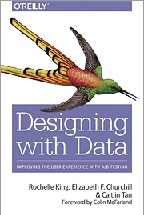 |
766:003.63 KIN King, Rochelle Beijing : O’Reilly Media, 2017
Contents [ Foreword ]; [ Preface ]; Introducing a Data Mindset; Data as a Trend; Three Ways to Think About Data; What Does This Mean for You as a Designer?; Data Can Help to Align Design with Business; With a Little Help from Your Friends…; What If You Don’t Have Data Friends (Yet)?; Themes You’ll See in This Book; Summary; Questions to Ask Yourself; The ABCs of Using Data; The Diversity of Data ; Why Experiment?; Basics of Experimentation; A/B Testing: Online Experiments; Your Hypothesis and Why It Matters; Running Creative A/B Tests; Summary; Questions to Ask Yourself
A Framework for ExperimentationIntroducing Our Framework; Three Phases: Definition, Execution, and Analysis; Examples: Data and Design in Action; Summary; Questions to Ask Yourself; The Definition Phase (How to Frame Your Experiments); Getting Started: Defining Your Goal; Identifying the Problem You Are Solving; Building Hypotheses for the Problem at Hand; The Importance of Going Broad; Which Hypotheses to Choose?; Summary; Questions to Ask Yourself; The Execution Phase (How to Put Your Experiments into Action); Designing to Learn; Designing the Best Representation of Your Hypothesis; Summary Questions to Ask YourselfThe Analysis Phase (Getting Answers From Your Experiments); Vetting Your Designs Ahead of Launch; Launching Your Design; Evaluating Your Results; What Does the Data Say?; Rolling Out Your Experience, or Not; Case Study: Netflix on PlayStation 3; Summary; Questions to Ask Yourself; Creating the Right Environment for Data-Aware Design; Principle 1: Shared Company Culture and Values; Principle 2: Hiring and Growing the Right People; Principle 3: Processes to Support and Align; Summary; Questions to Ask Yourself; Conclusion; Ethical Considerations ; Last Words; Resources Abstract On the surface, design practices and data science may not seem like obvious partners. But these disciplines actually work toward the same goal, helping designers and product managers understand users so they can craft elegant digital experiences. While data can enhance design, design can bring deeper meaning to data. This practical guide shows you how to conduct data-driven A/B testing for making design decisions on everything from small tweaks to large-scale UX concepts. Complete with real-world examples, this book shows you how to make data-driven design part of your product design workflow. •Understand the relationship between data, business, and design •Get a firm grounding in data, data types, and components of A/B testing •Use an experimentation framework to define opportunities, formulate hypotheses, and test different options •Create hypotheses that connect to key metrics and business goals •Design proposed solutions for hypotheses that are most promising •Interpret the results of an A/B test and determine your next move
Subject User-centered system design
Information visualization Web site development 40847 |
 |
London : Laurence King Publishing, 2012
Content The book -- Body type -- Rub-on designs -- Rays -- Pastiche -- Pointing fingers -- Vanitas -- Clenched fists -- Monumental images -- Female archetypes -- Color blocks -- Ornamentation -- Decorative logotypes -- Naive mascots -- Entrepreneurship -- Metaphoric lettering -- Swashes on caps -- Texts as images -- Visual puns -- The square format -- Primitive figuration -- Propaganda -- The object poster -- Paper cutouts -- Manifestos -- Graphic design magazines -- Botanical geometry -- Calligrams -- Loud typography -- Asymmetric typography -- Red with black -- Supergraphics -- Supreme geometry -- Funny faces -- Expression of speed -- Corporate identity -- Dust jackets -- Found typography -- Ransom notes -- Design handbooks -- Avant-garde zines -- Collages -- Riddles and rebuses -- Photomontage -- Pictograms -- Floating heads -- Abstraction -- Triangulation -- Extreme close-ups -- The provocative gesture -- Motion graphics -- Night spectaculars -- Shadow play -- Good design -- Forced obsolescence -- Vibrating color -- Strips and panels -- Frame by frame -- Perfect rectangles -- Abstract graphs -- Dynamic diagonals -- Stencil type -- Comic lettering -- Parody -- Sustainable packaging -- Public service campaigns -- Branding campaigns -- Layering and overprinting -- Design thinking -- The grid -- Brand narratives -- White space -- Less is more -- Monoalphabets -- Film title sequences -- Big book look -- Nostalgia -- Illegibility -- Scan lines -- Teen magazines -- Culture jamming -- High contrast -- Psychedelia -- Split fountain -- Underground comics -- Record album covers -- Street slogans -- Sexual taboo busting -- Self-promotional publishing -- Tags -- Universal pricing code -- Vernacular -- French theory -- Do it yourself -- The fine print -- Magazine coverlines -- Guerrilla advertising -- Pixelation -- Ambigrams -- Designers’ websites.
Abstract New in the "100 Ideas that Changed..." series, this book demonstrates how ideas influenced and defined graphic design, and how those ideas have manifested themselves in objects of design. The 100 entries, arranged broadly in chronological order, range from technical (overprinting, rub-on designs, split fountain); to stylistic (swashes on caps, loud typography, and white space); to objects (dust jackets, design handbooks); and methods (paper cut-outs, pixelation).
Subject Graphic arts -- Technological innovations.
Design -- Themes, motives. 40837 |
 |
77(091) קאמ קאמפני, דייוויד תל-אביב : פיתום הוצאה לאור, תשע"א 2011
Abstract הספר הוא תערוכה בפני עצמה: הקשר אנליטי בפורמט דפדופי – אפשר לשייט בין הדימויים ולחוש, להסיק, להבין. ואחר כך לקרוא. תקריבים, הקפאת פריימים ואינספור דמויות של צלמי תמונות על המסך הגדול הם אות למשיכה המתמדת של הקולנוע לדימוי התצלומי. ובד בבד: כיצד שינה הדימוי הנע את תפקידו החברתי של התצלום? מה הן ההשלכות האסתטיות, האינטלקטואליות והטכניות של הקולנוע על הצילום? כיצד שאלות של זמן ותנועה קולנועיים עיצבו מחדש את האין-תנועה, את הנייחות, של התצלום? צורניות עשירה התפתחה בתוך מרחב הכלאיים בין תנועה לאין-תנועה: תמונות קולנועיות, תצלום נע, ספרונים לדפדוף מהיר, רצפי שקופיות, דימויים דיגיטליים. ספרו של דייוויד קאמפני, "צילום, קולנוע, צילום", טוֹוה את סיפור ההשראה ההדדית בין שני המדיומים במהלך של יותר ממאה שנה באמצעות חתך נושאי לא ליניארי ובכתיבה מקורית-מסאית ועקרונית כאחד. קאמפני עוקב אחר מקומו של הדימוי הנייח הן בקולנוע האוונגרדי-נסיוני והן בזה הפופולרי - בסרטים מאת האחים לומייר, אלפרד היצ’קוק, מיכלאנג’לו אנטוניוני, ז’אן-לוק גודאר, כריס מרקר, מייקל סנואו, מארק לואיס, אנייס וארדה, פיטר וייר, כריסטופר נולן ורבים אחרים.
ובמקביל, הוא עוקב אחר הפן הקולנועי בעבודתם של צלמים ואמנים שהשפיעו על מגמות וכיוונים, ביניהם ז’רמן קרוּל, ויליאם קליין, ג’ון בלדסארי, ג’ון צזאקר, ג’ף וול, זואי ליאונרד, מיטרה טאבריזיאן, ויקטור ברג’ן, אלן סקולה וסינדי שרמן. המחבר פורס התפתחויות מכוננות וסימני שאלה בלשון בהירה ומדויקת וב-127 דימויים (רבים מהם בצבע) שבחר והציב בצירופים דיאלוגיים. רקע תיאורטי נרחב מזין את הבחנותיו של קאמפני, והמשך עיון מאפשרות הערותיו והביבליוגרפיה. א. ד. Subject Photography -- History.
Motion pictures -- History. Cinematography -- History 40780 |
 |
77.04(569.4) לוס (אזו) אזולאי, אריאלה חיים דעואל לוסקי : צילום אופקי
תל-אביב : רסלינג ; בת-ים : מובי - מוזיאוני בת ים, תשע"ז 2016
Abstract במהלך ארבעים השנים האחרונות יצר חיים דעואל לוסקי יותר משלושים מצלמות רב-מוקדיות, ייחודיות בצורתן ובחומריותן, הנבדלות זו מזו במבנה הפנימי שלהן (נקב, לשכה האפלה, סוג המצע שעליו נקלט הדימוי), במערכות אופטיות שונות המשבשות את אופן התנהגות האור ואת יחסי הגומלין שבין האור לחומר ובין האור למרחב. כל אחת ממצלמות אלה חוללה תופעות אופטיות חד-פעמיות והציעה תנאי אפשרות משלה למחשבה על מהות הצילום וליכולת לחשוב באמצעותו על העולם שבו הן מופעלות. ספר זה – המציג כל אחת ואחת מהמצלמות באופן פרטני ופרשני – הוא תוצר של שיתוף פעולה מתמשך בין חיים דעואל לוסקי לבין אריאלה אזולאי. יחד הם חוקרים את משטר הראייה שמיסד הצילום השגור – אנכי, חד-מוקדי – המתמסר בקלות להיגיון הריבוני ולעיקרון הקניין הקפיטליסטי
באמצעות מכשירים ייחודיים אלה, המשבשים את השליטה של הצלם במכשיר, ומזמנים התנסות בתופעות אופטיות סינגולריות ובלתי צפויות, בוחנים השניים את האפשרויות לשחרור מהכבלים של הצילום האנכי, לצד חלופות למשטר הראייה הרווח – בין השאר חלופות הנשענות על הפילוסופיה האופקית (דעואל לוסקי), כמו גם חלופות אזרחיות א-היררכיות המשוחררות מתביעת בעלות (אזולאי). הספר מציג את המצלמות כפרויקט סדרתי המשלב בין מחשבה תיאורטית ביקורתית לבין מעשה. ניתוח הפרויקט הזה מתנהל בארבעה מסלולים נרטיביים מקבילים, והוא המצע שעליו פורשת אזולאי היסטוריה פוטנציאלית של הצילום. זו מאפשרת לה לדחות את תפיסת הזמניות של הקידמה שמבעדה מוצג בדרך כלל הצילום כמתפתח לאורך זמן, התפתחות שהפכה את הקמרה אובסקורה למיושנת ונידונה לפנות את מקומה ולעבור מהעולם. המצלמות של דעואל לוסקי מוצבות במרחב של דמיון אזרחי -- |c מן המעטפת האחורית Per.Sub. De’u’el Lusḳi, Ḥayim -- Criticism and interpretation
Subject Photography, Artistic -- Israel.
Photography -- History. 40951 |
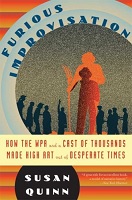 |
792(73) QUI Quinn, Susan New York : Walker & Co., 2009.
Contents On the train -- Harry -- Hallie -- Great plans for millions -- Ethiopia -- Triple-A plowed under -- Entr’acte 1: The CCC murder mystery -- The simple and the difficult -- Do you voodoo? -- It can’t happen here -- Entr’acte 2: After the flood -- Under a powerful star -- The cradle will rock -- I’d rather be right -- Chants of the prairies -- The west -- Past is present -- Enter HUAC -- Marlowe’s ghost -- An act of Congress -- Epilogue: Four febrile years.
Abstract The Federal Theater Project managed to turn a WPA relief program into a platform for some of the most inventive and cutting-edge theater of its time. This daring experiment in government support of the arts electrified audiences with exciting, controversial productions. Its plays stirred up politicians by putting the spotlight on social injustice, and starred some of the greatest figures in twentieth-century American arts, including Orson Welles, John Houseman, and Sinclair Lewis. Susan Quinn brings to life the politics of this desperate era when FDR, Eleanor Roosevelt, and chain-smoking idealist Harry Hopkins furiously improvised programs to get millions of hungry, unemployed people back to work. Quinn’s compelling story of politics and idealism reaches a climax with the rise of Martin Dies and the House Un-American Activities Committee, which turned the FTP into the first victim of a Red scare that would roil the nation for the next twenty years.--From publisher description.
Corp.Sub. Federal Theatre Project (U.S.)
United States. Work Projects Administration Subject Theaters
40827 |
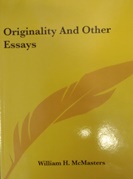 |
821.111(73) MCM McMasters, William H. Boston : Four Seas, 1921
Abstract This scarce antiquarian book is a facsimile reprint of the original. Due to its age, it may contain imperfections such as marks, notations, marginalia and flawed pages. Because we believe this work is culturally important, we have made it available as part of our commitment for protecting, preserving, and promoting the world’s literature in affordable, high quality, modern editions that are true to the original work.
Subject American literature
American literature -- 19th century -- History and criticism. 40755 |
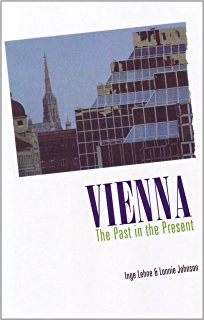 |
930.85(436) LEH Inge Lehne, Lonnie Johnson. Vienna, the past in the present : a historical survey / Second edition Wien : Österreichischer Bundesverlag ; Riverside, California : Ariadne Press, 1995 Contents Foundations. Roman walls ; A new start ; The upswing ; The Church’s contributions ; The early heritage -- Conflicts and consolidation. New lords : the Habsburgs ; Expanding the empire and suppressing Viennese autonomy ; The Turkish threat ; Renaissance perspectives ; Internal discord : reformation and counter ; Reformation -- Baroque : a festive society and onlooking masses. Protestants, plagues, and Turks ; Palaces. pomp, and processions ; Entertaining rituals and rituals of entertainment ; Looking and acting Baroque -- Enlightenment : an attempt at welfare. Wife, mother, empress, and reformer ; Josephinian innovation and impatience ; Public welfare ; Sobriety ; Artistic impulses -- Biedermeier : a culture of the home. Napolean, Metternich, and the Vienna Congress ; Defining a way of life ; Art in and for the home ; On and off stage ; The end of the Idyll ; The strength of tradition -- The new dimensions of the Ringstrabe. The boom years of liberalism ; Petty Bourgeois politics ; Working class misery and social democracy ; The rise of nationalism ; Starting the ring ; A Ringstrabe promenade ; Perspectives and parades -- Breaking with the past : modern sensibilities. "To every age its art; to art its freedom" ; Musical trends ; New literacy horizons ; The influence of Viennese schools -- The imperial capital becomes a socialist stronghold. Off to a bad start ; Old and new cultures ; Red Vienna ; Fortress mentalities ; The violent end -- The Nazi interlude : Vienna, Germany. The Anschlub ; Emigration and reorganization ; Persecution of the Jews ; Shifts in attitude ; Destruction, resistance, and liberation -- The aftermath : allied occupation. From chaos to order ; Occupation and four power control ; Liberated but not free ; Reconstruction ; Towards freedom and neutrality -- Old problems and new impulses. Preservation and innovation ; Traditional structures ; Internationalization ; Old and new Viennese.
Abstract "The best access to Vienna is through its history. This chronologically organized survey of Vienna from its origins to the present does not presuppose any detailed knowledge of Central European history. Accenting cultural, political and social influences, this book covers the following periods of development: the Roman settlement; the medieval residence of the Babenbergers and the early Habsburgs; the Turkish sieges, Reformation and Counter Reformation; the culture of the Baroque court; reforms of the Enlightenment; the lifestyle of Viennese Biedermeier; political and cultural transformations in the age of Francis Joseph; interwar Vienna; the Nazi occupation; post-World War II four power occupation; and the development of the city from 1955 until today." "Vienna: The Past in the Present is not merely a narrative of the past. The authors have attempted to show how certain historical events and developments still influence the city today. Special attention has been paid to describing traditions and attitudes which are peculiar to Vienna and the Viennese." --Book Jacket.
Subject Vienna (Austria) -- History.
Vienna (Austria) -- Civilization. 40744 |
- כתבות, חדשות ואירועים




